Evaluation of the Suitability of Geodetic Databases to Support the Process of Locating Renewable Energy Investments
Abstract
1. Introduction
1.1. Siting Criteria and Factors Relevant to RES Investments
1.2. Polish Geodetic Databases
- 0.10 m—in the case of field details of group I (e.g., buildings, construction equipment);
- 0.30 m—in the case of field details of group II (e.g., covered construction objects);
- 0.50 m—in the case of field details of group III.
1.3. Concept for Assessing the Suitability of BDOT10k and DEM Databases
2. Materials and Methods
2.1. Research Methodology
- —attribute completeness coefficient;
- —the number of attribute values in the research database;
- —the number of different attribute values in the reference database.
- —spatial completeness coefficient;
- —the product of the intersecting (overlapping) surfaces of the selected layer(s) in the research and reference databases within the research area;
- —the area of the examined layer within the analysis area;
- —the area of the reference layer within the research area.
- —spatial redundancy coefficient;
- —the product of the intersecting (overlapping) surfaces of the selected layer(s) in the research and reference databases within the research area;
- —the area of the examined layer within the analysis area;
- —the area of the reference layer within the research area.
- —the score value of the suitability coefficient of the BDOT10k and DEM databases for the research area;
- —another coefficient affecting the suitability of BDOT10k and DEM databases;
- —the j-th factor weight affecting the suitability of BDOT10k and DEM databases (Table 11).
- —the score value of the suitability coefficient of the BDOT10k and DEM databases for the research area;
- —the spatial completeness coefficient Kp of the BDOT10k database for the land use factor;
- —the spatial completeness coefficient Kp of the BDOT10k database for the water network factor;
- —the spatial completeness coefficient Kp of the BDOT10k database for the land cover objects (buildings) factor;
- —the spatial completeness coefficient Kp of the BDOT10k database for the transportation network factor;
- —the spatial completeness coefficient Kp of the BDOT10k database for utilities network factor;
- —the mean elevation error for the DEM dataset, as specified in the metadata;
- —the average value from the preliminary assessment of the three reference databases (EGiB, BDOT500, GESUT) for the test area.
2.2. Research Areas and Input Data for Analysis
3. Results
3.1. BDOT10k Database Data Completeness Results
3.1.1. Results for the Attribute Completeness Coefficient (Ka)
3.1.2. Results of the Spatial Completeness (Kp) and Spatial Redundancy (Np) Coefficients
3.2. Comparative Analysis of the Results Obtained for Spatial Completeness and Redundancy Coefficients by Research Factor
3.2.1. Land Use
3.2.2. Water Network
3.2.3. Land Cover Objects (Buildings)
3.2.4. Transportation Network
3.2.5. Utility Networks
3.3. Assessment of the Suitability of Publicly Accessible Geodetic Databases for RES
- 0–1.34 databases not suitable for RES;
- 1.35–2.15 databases suitable for RES;
- 2.16–2.70 databases fully suitable for RES.
4. Discussion and Conclusions
- (1)
- It is possible to determine the requirements of spatial data users related to the process of siting renewable energy infrastructure based on the existing extensive national and international literature regarding the first stage of investments, i.e., spatial analyses carried out in a GIS environment to identify areas predisposed to and excluded from investment siting;
- (2)
- As a result of the analysis of publicly available geodetic databases BDOT10k and NMT in 18 randomly selected locations from Poland, it was found that these databases contain data for the determination of research factors of importance in the process of localization of infrastructure for selected RES. The data are available in the databases, and with their help, it is possible to carry out research according to the methodology adopted in the study.
- (3)
- It was found that publicly accessible geodetic databases BDOT10k and DEM are useful in the process of RES infrastructure siting. The method for assessing the suitability of publicly accessible BDOT10k and DEM geodetic databases, proposed in this paper, allowed for the calculation of the suitability coefficient in all research areas. Similar analyses of geodetic databases from the perspective of a specific group of data users have not yet been conducted. Additionally, no studies have assessed the collective suitability of multiple geodetic databases in the form of a single coefficient.
Author Contributions
Funding
Data Availability Statement
Conflicts of Interest
Appendix A
| Author, Publication, Country | Categories of Factors | Factors Influencing Localisation | Factors Excluding Location | Spatial Data Used/Notes |
|---|---|---|---|---|
| Financial subsidies and the location decision of solar power plants in Hungary: An empirical investigation [52] |
|
|
| |
| Environmental decision-support systems for evaluating the carrying capacity of land areas: Optimal site selection for grid-connected photovoltaic power plants [23] Andalusia (Spain) |
|
|
|
|
| Location Study of Solar Thermal Power Plant in the State of Pernambuco Using Geoprocessing Technologies and Multiple-Criteria Analysis [10] Pernambuco, north-eastern region of Brazil |
|
|
|
|
| Site selection for solar power plant in Zaporizhia city (Ukraine) [11] Zaporizhia city (Ukraine) |
|
|
| |
| Improving the Efficiency of Solar Power Plants [30] Luxor (Egypt) |
|
|
| |
| Optimization of photovoltaic solar power plant locations in northern Chile [24] |
|
|
|
|
| Analyzing territory for the sustainable development of solar photovoltaic power using GIS [12] Valencia, eastern Spain |
|
|
|
|
| Regional Scale wind farm and solar farm suitability assessment using GIS-assisted multi-criteria evaluation [15] Area of southern England | Technical factors Visual factors Environmental factors Economic factors |
|
|
|
| PV site suitability analysis using GIS-based spatial fuzzy multi-criteria evaluation [25] Oman | Technical factors Economic factors Environmental factors |
|
|
|
| Author, Publication, Country | Categories of Factors | Factors Influencing Localisation | Factors Excluding Location | Spatial Data Used/Notes |
|---|---|---|---|---|
| Constraints on development of wind energy in Poland due to environmental objectives. Is there is space in Poland wind farm siting [18] | Settlement factors Landscape and environmental factors Visual factors Technical factors |
|
|
|
| Regional Scale wind farm and solar farm suitability assessment using GIS-assisted multi-criteria evaluation [15] Area of southern England | Technical factors Visual factors Environmental factors Economic factors |
|
|
|
| A multicriterial evaluation of land suitability for wind energy development, as exemplified by Poland’s gmina of Rymanów [13] | Technical factors |
|
|
|
| GIS-based environmental assessment of wind energy systems for spatial planning: A case study from Western Turkey [16] | The potential of wind energy Environmental |
|
|
|
| GIS-based method for wind farm location multi-criteria analysis Prusice municipality in Lower Silesia, Poland [14] | Environmental Social Spatial Technical |
|
| |
| Application of the GIS-DANP-MABAC multi-criteria model for selecting the location of wind farms: A case study of Vojvodina, Serbia [19] | Environmental Economic Social |
|
| |
| A Geospatial Approach for Prioritizing Wind Farm Development in Northeast Nebraska, USA [20] |
|
|
| |
| Factors in determining wind farm location: Integrating GQM, fuzzy DEMATEL, and ANP [21] Taiwan | Safety and quality Economy and benefits Social impressions Noise and harsh light Monitoring and ecology |
| ||
| Wind Energy–assessment of resources and investment problems in renewable sources of energy based on the commune Latowicz, Polska [22] | Environmental Topography |
|
|
|
| A Decision Support System methodology for selecting wind farm installation locations using AHP and TOPSIS: Case study in Eastern Macedonia and Thrace region, Greece [17] | Qualitative and quantitative criteria |
|
|
|
Appendix B
| Group of Research Areas | Area Designation | Name of Locality | Province | Surface Area [ha] | MultiPolygon Coordinates [Layout: ETRS89/Poland CS92] |
|---|---|---|---|---|---|
| W | W1 | Szczecin | Zchodniopomorskie | 25.15 | 199,713.41 624,880.71, 200,276.65 624,975.72, 200,545.40 624,610.02, 199,987.33 624,464.72, 199,713.41624,880.71 |
| W2 | Poznań | Wielkopolskie | 25.11 | 363,911.58 500,395.19, 364,206.12 500,188.69, 363,967.49 499,610.78, 363,597.77 499,749.76, 363,911.58 500,395.19 | |
| W3 | Łódź | Łódzkie | 23.18 | 540,368.50 432,383.94, 540,783.94 432,229.87, 540,640.66 431,745.07, 540,220.28 431,852.20, 540,368.49 432,383.94 | |
| P | P1 | Kielce | Świętokrzyskie | 28.64 | 614,079.63 337,093.91, 614,352.17 336,993.98, 614,352.17 336,993.98, 614,006.94 336,244.47, 613,639.01 336,530.65, 614,079.63 337,093.91 |
| P2 | Bielsko-Biała | Śląskie | 17.99 | 502,321.85 214,930.52, 502,401.10 214,987.91, 502,401.10 214,987.91, 502,791.89 214,884.06, 502,678.48 214,702.33, 502,500.85 214,494.64, 502,133.29 214,700.97 | |
| P3 | Olsztyn | Warmińsko-mazurskie | 24.62 | 597,330.20 655,369.99, 597,419.98 655,856.73, 597,934.05 655,893.47, 597,944.61 655,529.66, 597,728.73 655,441.52, 597,330.20 655,369.99 | |
| M | M1 | Jędrzejów | Świętokrzyskie | 21.08 | 588,855.37 308,268.77, 589,319.31 308,232.86, 589,151.21 307,746.52, 588,702.98 307,897.79, 588,855.36 308,268.77 |
| M2 | Grójec | Mazowieckie | 31.86 | 629,612.12 446,573.16, 630,063.93 446,512.11, 630,063.93 446,512.11, 630,012.03 445,788.61, 629,621.28 445,788.61, 629,612.12 446,573.16 | |
| M3 | Andrychów | Małopolskie | 24.29 | 523,418.85 222,229.56, 523,814.71 222,131.62, 523,699.23 221,572.84, 523,274.19 221,667.42, 523,418.85 222,229.56 | |
| GC | GC1 | Rajcza | Śląskie | 15.91 | 507,371.31 181,847.72, 507,607.65 182,133.67, 507,891.68 181,700.16, 507,650.27 181,511.11, 507,371.31 181,847.72 |
| GC2 | Łączna | Świętokrzyskie | 20.87 | 625,654.90 349,111.75, 626,018.43 349,385.84, 626,381.47 349,093.07, 625,996.99 348,812.53, 625,654.90 349,111.75 | |
| GC3 | Lubasz | Wielkopolskie | 19.25 | 333,135.53 556,970.50, 333,404.69 557,359.63, 333,734.27 557,192.20, 333,469.81 556,741.08, 333,135.53 556,970.50 | |
| GZ | GZ1 | Rycerka Dolna | Śląskie | 17.71 | 504,926.99 179,268.53, 505,310.77 179,339.06, 505,411.52 179,050.98, 505,009.76 178,991.32, 504,926.99 179,268.53 |
| GZ2 | Zagórze | Świętokrzyskie | 22.45 | 627,338.90 346,855.19, 627,978.25 346,762.66, 627,920.76 346,425.53, 627,253.17 346,527.31, 627,338.90 346,855.19 | |
| GZ3 | Klempicz | Wielkopolskie | 19.17 | 330,707.81 547,657.21, 331,169.98 547,872.51, 331,327.61 547,537.78, 330,876.58 547,310.96, 330,707.81 547,657.21 | |
| GR | GR1 | Rycerka Górna | Śląskie | 15.60 | 504,651.47 178,728.80, 504,876.21 178,793.10, 505,106.70 178,181.24, 504,854.54 178,134.80, 504,651.47 178,728.80 |
| GR2 | Występa | Świętokrzyskie | 23.10 | 621,803.52 347,638.56, 622,143.94 347,643.18, 622,338.93 347,004.25, 621,969.03 346,988.32, 621,803.52 347,638.56 | |
| GR3 | Stajkowo | Wielkopolskie | 21.66 | 330,502.35 554,134.67, 330,986.20 553,859.90, 330,766.19 553,537.07, 330,274.75 553,830.45, 330,502.35 554,134.67 |
Appendix C
| No. | Research Factor | Area | Databases Adopted for Research | Data Quality Element: 1. COMPLETENESS | ||||||
|---|---|---|---|---|---|---|---|---|---|---|
| Reference (Comparative) Database | Research Database | Descriptive Data (Attributes) | Spatial Data | |||||||
| Data Development Level: -Geodetic Database -Database + Vector Map -Complete Vector Map -Vector Map + Raster -Hybrid Data (Database + Vector + Raster) -Raster | Actual Number of Attributes of the Evaluated Base/Actual Number of Attributes in the Reference Base (Completeness of the Database Being Assessed in Relation to the Reference Database) | 1. Completeness (Kp) Degree of the Research Database in Relation to the Reference Database. 2. Redundancy (Np) Degree of the Research Database in Relation to the Reference Database. | ||||||||
| 1 | Land use | Łódź | EGiB | BDOT10k | FORESTS | BUILDINGS | FARMLAND | FORESTS | BUILDINGS | FARMLAND |
0.0 | 0.60 | 2.00 | 0 (Kp) 200 (Np) | 47.35 101.13 | 66.04 3.44 | |||||
| Geodetic database | Geodetic database | |||||||||
| Poznań | EGiB | BDOT10k | None | 0.6 | 2.00 | None | 59.87 75.50 | 69.10 7.33 | ||
| Geodetic database | Geodetic database | |||||||||
| Szczecin | EGiB | BDOT10k | 1.0 | 0.40 | 1.0 | 75.72 0.43 | 38.34 122.10 | 72.13 5.31 | ||
| Geodetic database | Geodetic database | |||||||||
| 2 | Water network | Łódź | BDOT500 | BDOT10k | 1.0 (1/1) | 11.03 152.55 | ||||
| Geodetic database | Geodetic database | |||||||||
| Poznań | BDOT500 | BDOT10k | 1.0 (1/1) | 5.94 13.16 | ||||||
| Geodetic database | Geodetic database | |||||||||
| Szczecin | BDOT500 | BDOT10k | None | None | ||||||
| Geodetic database | Geodetic database | |||||||||
| 3 | Land cover objects (buildings) | Łódź | EGiB | BDOT10k | 0.80 | 79.99 39.76 | ||||
| Geodetic database | Geodetic database | |||||||||
| Poznań | EGiB | BDOT10k | 1.00 | 97.33 1.42 | ||||||
| Geodetic database | Geodetic database | |||||||||
| Szczecin | EGiB | BDOT10k | 0.86 | 87.84 20.62 | ||||||
| Geodetic database | Geodetic database | |||||||||
| 4 | Transportation network | Łódź | BDOT500 | BDOT10k | 0.60 | (1/0) none in reference closed areas | 50.41 91.50 | 0.00 0.00 | ||
| Geodetic database | Geodetic database | |||||||||
| Poznań | BDOT500 | BDOT10k | 1.0 | 76.25 10.19 | ||||||
| Geodetic database | Geodetic database | |||||||||
| Szczecin | BDOT500 | BDOT10k | 0.33 | 25.29 141.37 | ||||||
| Geodetic database | Geodetic database | |||||||||
| 5 | Utility networks | Łódź | GESUT | BDOT10k | 1.5 | 4.92 1.39 | ||||
| Geodetic database | Geodetic database | |||||||||
| Poznań | GESUT | BDOT10k | 0.67 | 7.95 5.59 | ||||||
| Geodetic database | Geodetic database | |||||||||
| Szczecin | GESUT | BDOT10k | 1.0 | 4.98 1.17 | ||||||
| Geodetic database | Geodetic database | |||||||||
| No. | Research Factor | Area | Databases Adopted for Research | Data Quality Element: 1. COMPLETENESS | ||||||
|---|---|---|---|---|---|---|---|---|---|---|
| Reference (Comparative) Database | Research Database | Descriptive Data (Attributes) | Spatial Data | |||||||
| Data Development Level: -Geodetic Database -Database + Vector Map -Complete Vector Map -Vector Map + Raster -Hybrid Data (Database + Vector + Raster) -Raster | Actual Number of Attributes of the Evaluated Base/Actual Number of Attributes in the Reference Base (Completeness of the Database Being Assessed in Relation to the Reference Database) | 1. Completeness (Kp) Degree of the Research Database in Relation to the Reference Database. 2. Redundancy (Np) Degree of the Research Database in Relation to the Reference Database. | ||||||||
| 1 | Land use | Bielsko-Biała | EGiB | BDOT10k | FORESTS | BUILDINGS | FARMLAND | FORESTS | BUILDINGS | FARMLAND |
0.5 | 1.0 | 0.33 | 0 (Kp) 200 (Np) | 65.90 61.34 | 55.10 7.68 | |||||
| Geodetic database | Geodetic database | |||||||||
| Kielce | EGiB | BDOT10k | None | 1.0 | None | 0.00 2.00 | 70.53 54.97 | 0.00 2.00 | ||
| Geodetic database + vector base map | Geodetic database | |||||||||
| Olsztyn | EGiB | BDOT10k | 0.50 | 0.60 | 1.0 | 19.36 159.94 | 59.22 71.56 | 48.67 23.98 | ||
| Geodetic database | Geodetic database | |||||||||
| 2 | Water network | Bielsko-Biała | BDOT500 | BDOT10k | 0.67 | 34.68 40.79 | ||||
| Geodetic database | Geodetic database | |||||||||
| Kielce | BDOT500 | BDOT10k | 0 (0/1) None | 0 0 | ||||||
| Geodetic database | Geodetic database | |||||||||
| Olsztyn | BDOT500 | BDOT10k | 0.5 | 72.99 49.12 | ||||||
| Geodetic database | Geodetic database | |||||||||
| 3 | Land cover objects (buildings) | Bielsko-Biała | EGiB | BDOT10k | 1.67 | 89.86 3.52 | ||||
| Geodetic database | Geodetic database | |||||||||
| Kielce | EGiB | BDOT10k | 1.43 | 94.87 0.65 | ||||||
| Geodetic database | Geodetic database | |||||||||
| Olsztyn | EGiB | BDOT10k | 0.83 | 91.88 12.72 | ||||||
| Geodetic database | Geodetic database | |||||||||
| 4 | Transportation network | Bielsko-Biała | BDOT500 | BDOT10k | 0.67 | 64.84 58.63 | ||||
| Geodetic database | Geodetic database | |||||||||
| Kielce | BDOT500 | BDOT10k | Roads: 0.67 | Tracks: 1.00 | Roads: 60.38 32.48 | Tracks: 4.74 1.02 | ||||
| Geodetic database + vector base map | Geodetic database | |||||||||
| Olsztyn | BDOT500 | BDOT10k | 0.44 | 1.00 | 70.23 39.89 | 6.65 17.34 | ||||
| Geodetic database | Geodetic database | |||||||||
| 5 | Utility networks | Bielsko-Biała | GESUT | BDOT10k | 1.0 | 15.17 4.28 | ||||
| Geodetic database | Geodetic database | |||||||||
| Kielce | GESUT | BDOT10k | 0.40 | 4.34 21.73 | ||||||
| Geodetic database | Geodetic database | |||||||||
| Olsztyn | GESUT | BDOT10k | 1.0 | 2.02 3.35 | ||||||
| Geodetic database | Geodetic database | |||||||||
| No. | Research Factor | Area | Databases Adopted for Research | Data Quality Element: 1. COMPLETENESS | ||||||
|---|---|---|---|---|---|---|---|---|---|---|
| Reference (Comparative) Database | Research Database | Descriptive Data (Attributes) | Spatial Data | |||||||
| Data Development Level: -Geodetic Database -Database + Vector Map -Complete Vector Map -Vector Map + Raster -Hybrid Data (Database + Vector + Raster) -Raster | Actual Number of Attributes of the Evaluated Base/Actual Number of Attributes in the Reference Base (Completeness of the Database Being Assessed in Relation to the Reference Database) | 1. Completeness (Kp) Degree of the Research Database in Relation to the Reference Database. 2. Redundancy (Np) Degree of the Research Database in Relation to the Reference Database. | ||||||||
| 1 | Land use | Andrychów | EGiB | BDOT10k | FORESTS | BUILDINGS | FARMLAND | FORESTS | BUILDINGS | FARMLAND |
| 0.5 | 1.0 | 1.0 | 48.15 66.76 | 72.50 53.40 | 82.13 0.50 | |||||
| Geodetic database | Geodetic database | |||||||||
| Jędrzejów | BDOT10k | 1/0 None in reference | 1.0 | 0.7 | 100 0 | 68.91 55.63 | 92.62 2.25 | |||
| vector map + raster | Geodetic database | |||||||||
| Grójec | EGiB | BDOT10k | None | 0.8 | 1.0 | None | 84.52 1.93 | 67.56 62.25 | ||
| database + vector map | Geodetic database | |||||||||
| 2 | Water network | Andrychów | BDOT500 | BDOT10k | 0.33 | 22.45 (Kp) 98.44 (Np) | ||||
| Geodetic database | Geodetic database | |||||||||
| Jędrzejów | BDOT10k | 1.0 | 46.08 20.04 | |||||||
| vector map + raster | Geodetic database | |||||||||
| Grójec | BDOT10k | None | None | |||||||
| vector map + raster | Geodetic database | |||||||||
| 3 | Land cover objects (buildings) | Andrychów | EGiB | BDOT10k | 0.50 | 76.65 34.86 | ||||
| Geodetic database | Geodetic database | |||||||||
| Jędrzejów | BDOT10k | 0.71 | 97.97 2.41 | |||||||
| vector map + raster | Geodetic database | |||||||||
| Grójec | BDOT10k | 0.63 | 84.86 3.93 | |||||||
| complete vector map | Geodetic database | |||||||||
| 4 | Transportation network | Andrychów | BDOT500 | BDOT10k | 0.43 | 43.50 80.47 | ||||
| Geodetic database | Geodetic database | |||||||||
| Jędrzejów | BDOT10k | 0.33 | 23.67 10.75 | |||||||
| vector map + raster | Geodetic database | |||||||||
| Grójec | BDOT10k | 0.57 | 64.42 8.59 | |||||||
| complete vector map | Geodetic database | |||||||||
| 5 | Utility networks | Andrychów | BDOT10k | 2.0 | 0.07 15.50 | |||||
| complete vector map | Geodetic database | |||||||||
| Jędrzejów | BDOT10k | 1.0 | 12.30 3.07 | |||||||
| vector map + raster | Geodetic database | |||||||||
| Grójec | BDOT10k | 1.0 | 5.63 5.25 | |||||||
| complete vector map | Geodetic database | |||||||||
| No. | Research Factor | Area | Databases Adopted for Research | Data Quality Element: 1. COMPLETENESS | ||||||
|---|---|---|---|---|---|---|---|---|---|---|
| Reference (Comparative) Database | Research Database | Descriptive Data (Attributes) | Spatial Data | |||||||
| Data Development Level: -Geodetic Database -Database + Vector Map -Complete Vector Map -Vector Map + Raster -Hybrid Data (Database + Vector + Raster) -Raster | Actual Number of Attributes of the Evaluated Base/Actual Number of Attributes in the Reference Base (Completeness of the Database Being Assessed in Relation to the Reference Database) | 1. Completeness (Kp) Degree of the Research Database in Relation to the Reference Database. 2. Redundancy (Np) Degree of the Research Database in Relation to the Reference Database. | ||||||||
| 1 | Land use | Lubasz | EGiB | BDOT10k | FORESTS | BUILDINGS | FARMLAND | FORESTS | BUILDINGS | FARMLAND |
| 0.5 | 0.75 | 0.67 | 56.46 33.78 | 72.45 38.78 | 50.47 10.44 | |||||
| Geodetic database | Geodetic database | |||||||||
| Rajcza | EGiB | BDOT10k | 1.0 | 0.75 | 0.50 | 66.43 3.66 | 48.41 20.87 | 68.04 51.94 | ||
| Geodetic database | Geodetic database | |||||||||
| Łączna | BDOT10k | 0.5 | 1.0 | 0.67 | 44.03 4.41 | 66.36 18.74 | 64.58 59.63 | |||
| complete vector map | Geodetic database | |||||||||
| 2 | Water network | Lubasz | BDOT500 | BDOT10k | 1/0 None in BDOT500 and raster. | 0 (Kp) 152.45 (Np) | ||||
| database + raster | Geodetic database | |||||||||
| Rajcza | BDOT10k | 2.0 | 3.14 94.37 | |||||||
| complete vector map | Geodetic database | |||||||||
| Łączna | BDOT10k | 1.0 | 40.16 96.81 | |||||||
| complete vector map | Geodetic database | |||||||||
| 3 | Land cover objects (buildings) | Lubasz | EGiB | BDOT10k | 1.8 | 94.42 4.35 | ||||
| Geodetic database | Geodetic database | |||||||||
| Rajcza | EGiB | BDOT10k | 1.13 | 95.71 5.35 | ||||||
| Geodetic database | Geodetic database | |||||||||
| Łączna | BDOT10k | 1.40 | 94.08 1.97 | |||||||
| complete vector map | Geodetic database | |||||||||
| 4 | Transportation network | Lubasz | BDOT500 | BDOT10k | 1.50 | 69.05 21.38 | ||||
| database + raster | Geodetic database | |||||||||
| Rajcza | BDOT10k | 0.67 | 56.36 54.11 | |||||||
| complete vector map | Geodetic database | |||||||||
| Łączna | BDOT10k | 1.0 | 74.86 26.52 | |||||||
| complete vector map | Geodetic database | |||||||||
| 5 | Utility networks | Lubasz | GESUT | BDOT10k | 0.67 | 2.15 73.05 | ||||
| database + raster | Geodetic database | |||||||||
| Rajcza | BDOT10k | 0.67 | 2.49 12.46 | |||||||
| complete vector map | Geodetic database | |||||||||
| Łączna | BDOT10k | 0.33 | 4.24 24.47 | |||||||
| complete vector map | Geodetic database | |||||||||
| No. | Research Factor | Area | Databases Adopted for Research | Data Quality Element: 1. COMPLETENESS | ||||||
|---|---|---|---|---|---|---|---|---|---|---|
| Reference (Comparative) Database | Research Database | Descriptive Data (Attributes) | Spatial Data | |||||||
| Data Development Level: -Geodetic Database -Database + Vector Map -Complete Vector Map -Vector Map + Raster -Hybrid Data (Database + Vector + Raster) -Raster | Actual Number of Attributes of the Evaluated Base/Actual Number of Attributes in the Reference Base (Completeness of the Database Being Assessed in Relation to the Reference Database) | 1. Completeness (Kp) Degree of the Research Database in Relation to the Reference Database. 2. Redundancy (Np) Degree of the Research Database in Relation to the Reference Database. | ||||||||
| 1 | Land use | Klempicz | EGiB | BDOT10k | FORESTS | BUILDINGS | FARMLAND | FORESTS | BUILDINGS | FARMLAND |
| 2.0 | 0.60 | 0.33 | 46.83 13.61 | 54.91 76.45 | 71.18 21.08 | |||||
| Geodetic database | Geodetic database | |||||||||
| Rycerka Dolna | EGiB | BDOT10k | 2/0 None in reference | 1.0 | 1.0 | 0 0 | 33.09 2.06 | 51.97 64.33 | ||
| Geodetic database | Geodetic database | |||||||||
| Zagórze | BDOT10k | (1/0) None in reference | 1.0 | 0.67 | 0 0 | 87.93 18.35 | 93.16 9.87 | |||
| complete vector map | Geodetic database | |||||||||
| 2 | Water network | Klempicz | BDOT500 | BDOT10k | 1.5 | 29.66 (Kp) 70.01 (Np) | ||||
| database + raster | Geodetic database | |||||||||
| Rycerka Dolna | BDOT10k | 2.00 | 18.10 12.04 | |||||||
| complete vector map | Geodetic database | |||||||||
| Zagórze | BDOT10k | (2/0) None in reference | 0 0 | |||||||
| complete vector map | Geodetic database | |||||||||
| 3 | Land cover objects (buildings) | Klempicz | EGiB | BDOT10k | 0.75 | 92.92 9.15 | ||||
| hybrid data (database + vector + raster) | Geodetic database | |||||||||
| Rycerka Dolna | EGiB | BDOT10k | 0.29 | 88.87 12.60 | ||||||
| Geodetic database | Geodetic database | |||||||||
| Zagórze | BDOT10k | 0.40 | 97.94 3.94 | |||||||
| complete vector map | Geodetic database | |||||||||
| 4 | Transportation network | Klempicz | BDOT500 | BDOT10k | 1.0 | 57.11 15.70 | ||||
| hybrid data (database + vector + raster) | Geodetic database | |||||||||
| Rycerka Dolna | BDOT10k | 1.50 | 68.36 10.26 | |||||||
| complete vector map | Geodetic database | |||||||||
| Zagórze | BDOT10k | 2.00 | 75.36 2.58 | |||||||
| complete vector map | Geodetic database | |||||||||
| 5 | Utility networks | Lubasz | GESUT | BDOT10k | 0.50 | 3.13 15.77 | ||||
| hybrid data (database + vector + raster) | Geodetic database | |||||||||
| Rajcza | BDOT10k | 1.0 | 7.13 178.22 | |||||||
| complete vector map | Geodetic database | |||||||||
| Łączna | BDOT10k | 1.5 | 2.53 17.10 | |||||||
| complete vector map | Geodetic database | |||||||||
| No. | Research Factor | Area | Databases Adopted for Research | Data Quality Element: 1. COMPLETENESS | ||||||
|---|---|---|---|---|---|---|---|---|---|---|
| Reference (Comparative) Database | Research Database | Descriptive Data (Attributes) | Spatial Data | |||||||
| Data Development Level: -Geodetic Database -Database + Vector Map -Complete Vector Map -Vector Map + Raster -Hybrid Data (Database + Vector + Raster) -Raster | Actual Number of Attributes of the Evaluated Base/Actual Number of Attributes in the Reference Base (Completeness of the Database Being Assessed in Relation to the Reference Database) | 1. Completeness (Kp) Degree of the Research Database in Relation to the Reference Database. 2. Redundancy (Np) Degree of the Research Database in Relation to the Reference Database. | ||||||||
| 1 | Land use | Stajkowo | EGiB | BDOT10k | FORESTS | BUILDINGS | FARMLAND | FORESTS | BUILDINGS | FARMLAND |
- | - | 1.00 | - | - | 97.07 0.00 | |||||
| Geodetic database | Geodetic database | |||||||||
| Rycerka Górna | EGiB | BDOT10k | - | - | 1.00 | - | - | 93.87 0.00 | ||
| Geodetic database | Geodetic database | |||||||||
| Występa | BDOT10k | 0.5 | - | 0.67 | 43.77 2.65 | - | 93.41 11.98 | |||
| vector map + raster | Geodetic database | |||||||||
| 2 | Water network | Stajkowo | BDOT500 | BDOT10k | 2/0 None in reference | 24.17 (Kp) 145.46 (Np) | ||||
| database + vector map | Geodetic database | |||||||||
| Rycerka Górna | BDOT10k | None | None | |||||||
| complete vector map | Geodetic database | |||||||||
| Występa | BDOT10k | None | None | |||||||
| complete vector map | Geodetic database | |||||||||
| 3 | Land cover objects (buildings) | Stajkowo | EGiB | BDOT10k | None | None | ||||
| Geodetic database | Geodetic database | |||||||||
| Rycerka Górna | BDOT10k | None | None | |||||||
| complete vector map | Geodetic database | |||||||||
| Występa | BDOT10k | None | None | |||||||
| vector map + raster | Geodetic database | |||||||||
| 4 | Transportation network | Stajkowo | BDOT500 | BDOT10k | None | None | ||||
| hybrid data (database + vector + raster) | Geodetic database | |||||||||
| Rycerka Górna | BDOT10k | 0 (0/1) None in BDOT10k | 0.00 200.00 | |||||||
| complete vector map | Geodetic database | |||||||||
| Występa | BDOT10k | 1.0 | 24.02 13.89 | |||||||
| complete vector map | Geodetic database | |||||||||
| 5 | Utility networks | Stajkowo | GESUT | BDOT10k | None | None | ||||
| hybrid data (database + vector + raster) | Geodetic database | |||||||||
| Rajcza | BDOT10k | 1.0 (1/1) | 0.82 0.04 | |||||||
| complete vector map | Geodetic database | |||||||||
| Łączna | BDOT10k | 1.0 | 8.31 3.75 | |||||||
| complete vector map | Geodetic database | |||||||||
Appendix D
| Łódź | |||
| Suitability element | Weight | Coefficient score value | Product |
| 2 | 0.05 | 0.10 | |
| 2 | 0.50 | 1.00 | |
| 2 | 0.80 | 1.60 | |
| 1 | 0.11 | 0.11 | |
| 3 | 0.38 | 1.13 | |
| 3 | 1.00 | 3.00 | |
| 3 | 10.00 | 30.00 | |
| total | 16 | total | 36.94 |
| 2.31 | |||
| Poznań | |||
| Suitability element | Weight | Coefficient score value | Product |
| 2 | 0.59 | 1.18 | |
| 2 | 0.86 | 1.72 | |
| 2 | 0.99 | 1.98 | |
| 1 | 0.70 | 0.70 | |
| 3 | 0.79 | 2.37 | |
| 3 | 1.00 | 3.00 | |
| 3 | 10.00 | 30.00 | |
| total | 16 | suma | 40.95 |
| 2.56 | |||
| Szczecin | |||
| Suitability element | Weight | Coefficient score value | Product |
| 2 | 0.05 | 0.10 | |
| 2 | 0.25 | 0.50 | |
| 2 | 0.88 | 1.76 | |
| 1 | 0.00 | 0.00 | |
| 3 | 0.62 | 1.86 | |
| 3 | 1.00 | 3.00 | |
| 3 | 10.00 | 30.00 | |
| total | 16 | suma | 37.22 |
| 2.33 | |||
| Bielsko-Biała | |||
| Suitability Element | Weight | Coefficient Score Value | Product |
| 2 | 0.15 | 0.30 | |
| 2 | 0.65 | 1.30 | |
| 2 | 0.90 | 1.80 | |
| 1 | 0.35 | 0.35 | |
| 3 | 0.54 | 1.62 | |
| 3 | 1.00 | 3.00 | |
| 3 | 10.00 | 30.00 | |
| total | 16 | suma | 38.37 |
| 2.40 | |||
| Kielce | |||
| Suitability element | Weight | Coefficient score value | Product |
| 2 | 0.04 | 0.08 | |
| 2 | 0.60 | 1.20 | |
| 2 | 0.95 | 1.90 | |
| 1 | 0.00 | 0.00 | |
| 3 | 0.24 | 0.71 | |
| 3 | 0.86 | 2.58 | |
| 3 | 10.00 | 30.00 | |
| total | 16 | suma | 36.47 |
| 2.28 | |||
| Olsztyn | |||
| Suitability element | Weight | Coefficient score value | Product |
| 2 | 0.02 | 0.04 | |
| 2 | 0.70 | 1.40 | |
| 2 | 0.92 | 1.84 | |
| 1 | 0.73 | 0.73 | |
| 3 | 0.42 | 1.27 | |
| 3 | 1.00 | 3.00 | |
| 3 | 10.00 | 30.00 | |
| total | 16 | suma | 38.28 |
| 2.39 | |||
| Jędrzejów | |||
| Suitability element | Weight | Coefficient score value | Product |
| 2 | 0.12 | 0.24 | |
| 2 | 0.24 | 0.48 | |
| 2 | 0.98 | 1.96 | |
| 1 | 0.46 | 0.46 | |
| 3 | 0.87 | 2.60 | |
| 3 | 0.30 | 0.90 | |
| 3 | 6.67 | 20.00 | |
| total | 16 | suma | 26.64 |
| 1.67 | |||
| Andrychów | |||
| Suitability element | Weight | Coefficient score value | Product |
| 2 | 0.16 | 0.32 | |
| 2 | 0.44 | 0.88 | |
| 2 | 0.77 | 1.54 | |
| 1 | 0.23 | 0.23 | |
| 3 | 0.67 | 2.02 | |
| 3 | 0.90 | 2.70 | |
| 3 | 6.67 | 20.00 | |
| total | 16 | suma | 27.69 |
| 1.73 | |||
| Grójec | |||
| Suitability element | Weight | Coefficient score value | Product |
| 2 | 0.06 | 0.12 | |
| 2 | 0.64 | 1.28 | |
| 2 | 0.85 | 1.70 | |
| 1 | 0.00 | 0.00 | |
| 3 | 0.77 | 2.30 | |
| 3 | 0.73 | 2.19 | |
| 3 | 6.67 | 20.00 | |
| total | 16 | suma | 27.59 |
| 1.72 | |||
| Lubasz | |||
| Suitability element | Weight | Coefficient score value | Product |
| 2 | 0.02 | 0.04 | |
| 2 | 0.69 | 1.38 | |
| 2 | 0.94 | 1.88 | |
| 1 | 0.29 | 0.29 | |
| 3 | 0.59 | 1.78 | |
| 3 | 0.53 | 1.59 | |
| 3 | 6.67 | 20.00 | |
| total | 16 | suma | 26.96 |
| 1.69 | |||
| Rajcza | |||
| Suitability element | Weight | Coefficient score value | Product |
| 2 | 0.02 | 0.04 | |
| 2 | 0.56 | 1.12 | |
| 2 | 0.96 | 1.92 | |
| 1 | 0.03 | 0.03 | |
| 3 | 0.61 | 1.82 | |
| 3 | 0.73 | 2.19 | |
| 3 | 10.00 | 30.00 | |
| total | 16 | suma | 37.12 |
| 2.32 | |||
| Łączna | |||
| Suitability element | Weight | Coefficient score value | Product |
| 2 | 0.04 | 0.08 | |
| 2 | 0.75 | 1.50 | |
| 2 | 0.94 | 1.88 | |
| 1 | 0.40 | 0.40 | |
| 3 | 0.58 | 1.75 | |
| 3 | 0.70 | 2.10 | |
| 3 | 6.67 | 20.00 | |
| total | 16 | suma | 27.71 |
| 1.73 | |||
| Klempicz | |||
| Suitability element | Weight | Coefficient score value | Product |
| 2 | 0.03 | 0.06 | |
| 2 | 0.18 | 0.36 | |
| 2 | 0.93 | 1.86 | |
| 1 | 0.30 | 0.30 | |
| 3 | 0.58 | 1.73 | |
| 3 | 0.53 | 1.59 | |
| 3 | 6.67 | 20.00 | |
| total | 16 | suma | 25.90 |
| 1.62 | |||
| Rycerka Dolna | |||
| Suitability element | Weight | Coefficient score value | Product |
| 2 | 0.07 | 0.14 | |
| 2 | 0.68 | 1.36 | |
| 2 | 0.89 | 1.78 | |
| 1 | 0.18 | 0.18 | |
| 3 | 0.43 | 1.28 | |
| 3 | 0.73 | 2.19 | |
| 3 | 10.00 | 30.00 | |
| total | 16 | suma | 36.93 |
| 2.31 | |||
| Zagórze | |||
| Suitability element | Weight | Coefficient score value | Product |
| 2 | 0.03 | 0.06 | |
| 2 | 0.75 | 1.50 | |
| 2 | 0.98 | 1.96 | |
| 1 | 0.00 | 0.00 | |
| 3 | 0.91 | 2.72 | |
| 3 | 0.70 | 2.10 | |
| 3 | 6.67 | 20.00 | |
| total | 16 | suma | 28.34 |
| 1.77 | |||
| Stajkowo | |||
| Suitability element | Weight | Coefficient score value | Product |
| 2 | 0.00 | 0.00 | |
| 2 | 0.00 | 0.00 | |
| 2 | 0.00 | 0.00 | |
| 1 | 0.24 | 0.24 | |
| 3 | 0.97 | 2.91 | |
| 3 | 0.53 | 1.59 | |
| 3 | 6.67 | 20.00 | |
| total | 16 | suma | 24.74 |
| 1.55 | |||
| Rycerka Górna | |||
| Suitability element | Weight | Coefficient score value | Product |
| 2 | 0.08 | 0.16 | |
| 2 | 0.00 | 0.00 | |
| 2 | 0.00 | 0.00 | |
| 1 | 0.00 | 0.00 | |
| 3 | 0.94 | 2.82 | |
| 3 | 0.73 | 2.19 | |
| 3 | 10.00 | 30.00 | |
| total | 16 | suma | 35.17 |
| 2.20 | |||
| Występa | |||
| Suitability element | Weight | Coefficient score value | Product |
| 2 | 0.08 | 0.16 | |
| 2 | 0.24 | 0.48 | |
| 2 | 0.00 | 0.00 | |
| 1 | 0.00 | 0.00 | |
| 3 | 0.69 | 2.06 | |
| 3 | 0.56 | 1.68 | |
| 3 | 6.67 | 20.00 | |
| total | 16 | suma | 24.38 |
| 1.52 | |||
References
- Tomaszewski, K.; Sekściński, A. Odnawialne Źródła Energii w Polsce—Perspektywa Lokalna i Regionalna. Rynek Energii 2020, 4, 10–19. [Google Scholar]
- Dmowski, A. Rosłaniec Łukasz Odnawialne Źródła Energii—Możliwości i Ograniczenia w Warunkach Polskich. In Proceedings of the II Szkoła Energetyki Jądrowej, Warszawa, Poland, 3 November 2009; pp. 1–16. [Google Scholar]
- Agencja Rynku Energii, S.A. Sytuacja Energetyczna w Polsce—Krajowy Bilans Energii. Q. Bull. 2023, 4, 1–51. [Google Scholar]
- Statistics Poland Energy from Renewable Sources in 2022. Available online: https://stat.gov.pl/en/topics/environment-energy/energy/energy-from-renewable-sources-in-2022,9,2.html (accessed on 15 July 2024).
- Teleszewski, T.J. Warianty Lokalizacji Elektrowni Wiatrowych w Obszarze Zurbanizowanym Na Podstawie Pomiaru Prędkości Wiatru—Badania Wstępne. Bud. O Zoptymalizowanym Potencjale Energetycznym 2018, 7, 83–88. [Google Scholar] [CrossRef]
- European Small Hydropower Association. State of the Art of Small Hydropower in EU-25. Policy 2010, 12, 14. Available online: https://www.globalccsinstitute.com/resources/publications-reports-research/state-of-the-art-of-small-hydropower-in-eu-25/ (accessed on 11 May 2023).
- Asoh, D.A.; Mbinkar, E.N.; Moutlen, A.N. Load Frequency Control of Small Hydropower Plants Using One-Input Fuzzy PI Controller with Linear and Non-Linear Plant Model. Smart Grid Renew. Energy 2022, 13, 1–16. [Google Scholar] [CrossRef]
- Chen, J.; Li, H. Analysis of Switching Overvoltage in Regional Grid with Small Hydropower Plants. Engineering 2013, 5, 19–23. [Google Scholar] [CrossRef]
- Kwartnik-Pruc, A.; Mączyńska, A. Methodology of Assessing Quality of Spatial Data Describing Course of Shoreline as Tool Supporting Water Resource Management Process. J. Water Land Dev. 2023, 167–180. [Google Scholar] [CrossRef]
- Azevêdo, V.; Candeias, A.; Tiba, C. Location Study of Solar Thermal Power Plant in the State of Pernambuco Using Geoprocessing Technologies and Multiple-Criteria Analysis. Energies 2017, 10, 1042. [Google Scholar] [CrossRef]
- Yankiv-Vitkovska, L.; Peresunko, B.; Wyczałek, I.; Papis, J. Site Selection for Solar Power Plant in Zaporizhia City (Ukraine). Geod. Cartogr. 2023, 69, 97–116. [Google Scholar] [CrossRef]
- Guaita-Pradas, I.; Marques-Perez, I.; Gallego, A.; Segura, B. Analyzing Territory for the Sustainable Development of Solar Photovoltaic Power Using GIS Databases. Environ. Monit. Assess. 2019, 191, 764. [Google Scholar] [CrossRef]
- Synowiec, W.; Luc, M. A Multicriterial Evaluation of Land Suitability for Wind Energy Development, as Exemplified by Poland’s Gmina of Rymanów. Przegląd Geogr. 2013, 85, 323–352. [Google Scholar] [CrossRef]
- Szurek, M.; Blachowski, J.; Nowacka, A. GIS-Based Method for Wind Farm Location Multi-Criteria Analysis. Min. Sci. 2014, 21, 65–81. [Google Scholar]
- Watson, J.J.W.; Hudson, M.D. Regional Scale Wind Farm and Solar Farm Suitability Assessment Using GIS-Assisted Multi-Criteria Evaluation. Landsc. Urban Plan. 2015, 138, 20–31. [Google Scholar] [CrossRef]
- Aydin, N.Y.; Kentel, E.; Duzgun, S. GIS-Based Environmental Assessment of Wind Energy Systems for Spatial Planning: A Case Study from Western Turkey. Renew. Sustain. Energy Rev. 2010, 14, 364–373. [Google Scholar] [CrossRef]
- Konstantinos, I.; Georgios, T.; Garyfalos, A. A Decision Support System Methodology for Selecting Wind Farm Installation Locations Using AHP and TOPSIS: Case Study in Eastern Macedonia and Thrace Region, Greece. Energy Policy 2019, 132, 232–246. [Google Scholar] [CrossRef]
- Hajto, M.; Cichocki, Z.; Bidłasik, M.; Borzyszkowski, J.; Kuśmierz, A. Constraints on Development of Wind Energy in Poland Due to Environmental Objectives. Is There Space in Poland for Wind Farm Siting? Environ. Manag. 2017, 59, 204–217. [Google Scholar] [CrossRef]
- Gigović, L.; Pamučar, D.; Božanić, D.; Ljubojević, S. Application of the GIS-DANP-MABAC Multi-Criteria Model for Selecting the Location of Wind Farms: A Case Study of Vojvodina, Serbia. Renew. Energy 2017, 103, 501–521. [Google Scholar] [CrossRef]
- Miller, A.; Li, R. A Geospatial Approach for Prioritizing Wind Farm Development in Northeast Nebraska, USA. ISPRS Int. J. Geoinf. 2014, 3, 968–979. [Google Scholar] [CrossRef]
- Yeh, T.-M.; Huang, Y.-L. Factors in Determining Wind Farm Location: Integrating GQM, Fuzzy DEMATEL, and ANP. Renew. Energy 2014, 66, 159–169. [Google Scholar] [CrossRef]
- Majewski, G.; Nasilowska, B. Wind Energy—Assessment of Resources and Investment Problems in Renewable Sources of Energy Based on the Commune Latowicz. Sci. Rev.-Eng. Environ. Sci. 2011, 51, 61–71. [Google Scholar]
- Arán Carrión, J.; Espín Estrella, A.; Aznar Dols, F.; Zamorano Toro, M.; Rodríguez, M.; Ramos Ridao, A. Environmental Decision-Support Systems for Evaluating the Carrying Capacity of Land Areas: Optimal Site Selection for Grid-Connected Photovoltaic Power Plants. Renew. Sustain. Energy Rev. 2008, 12, 2358–2380. [Google Scholar] [CrossRef]
- Suuronen, A.; Lensu, A.; Kuitunen, M.; Andrade-Alvear, R.; Celis, N.G.; Miranda, M.; Perez, M.; Kukkonen, J.V.K. Optimization of Photovoltaic Solar Power Plant Locations in Northern Chile. Environ. Earth Sci. 2017, 76, 824. [Google Scholar] [CrossRef]
- Charabi, Y.; Gastli, A. PV Site Suitability Analysis Using GIS-Based Spatial Fuzzy Multi-Criteria Evaluation. Renew. Energy 2011, 36, 2554–2561. [Google Scholar] [CrossRef]
- Tsoutsos, T.; Maria, E.; Mathioudakis, V. Sustainable Siting Procedure of Small Hydroelectric Plants: The Greek Experience. Energy Policy 2007, 35, 2946–2959. [Google Scholar] [CrossRef]
- Jeftenić, G.; Rašeta, A.; Kolaković, S.; Panić, M.; Kolaković, S.; Mandić, V. A Methodology Proposal for Selecting the Optimal Location for Small Hydropower Plants. Teh. Vjesn.-Tech. Gaz. 2021, 28, 1462–1470. [Google Scholar] [CrossRef]
- Rojanamon, P.; Chaisomphob, T.; Bureekul, T. Application of Geographical Information System to Site Selection of Small Run-of-River Hydropower Project by Considering Engineering/Economic/Environmental Criteria and Social Impact. Renew. Sustain. Energy Rev. 2009, 13, 2336–2348. [Google Scholar] [CrossRef]
- Nur, W.H.; Yuliana, Y.; Susilowati, Y.; Kumoro, Y.; Yunarto, Y. Overview about GIS Multi-Criteria Spatial Analysis for Micro Hydropower Plant Site Suitability in South Ogan Komering Ulu District, South Sumatera, Indonesia. Bull. Electr. Eng. Inform. 2021, 10, 1024–1034. [Google Scholar] [CrossRef]
- Strebkov, D.S.; Shogenov, Y.K.; Bobovnikov, N.Y. Improving the Efficiency of Solar Power Plants. Eng. Technol. Syst. 2020, 30, 480–497. [Google Scholar] [CrossRef]
- Kwartnik-Pruc, A.; Mączyńska, A. Assessing Validity of Employing Surveying Methods to Capture Data on Topography to Determine Hydrological and Topographic Parameters Essential for Selecting Locations for the Construction of Small Hydropower Plants. Energies 2022, 15, 1527. [Google Scholar] [CrossRef]
- Act of 17 May 1989 Geodetic and Cartographic Law. Official Journal of 2024, Item 1151 (as Amended). Available online: https://isap.sejm.gov.pl/isap.nsf/download.xsp/WDU19890300163/U/D19890163Lj.pdf (accessed on 15 September 2024).
- Izdebski, W.; Seremet, A. Praktyczne Aspekty Infrastruktury Danych Przestrzennych w Polsce; Główny Urząd Geodezji i Kartografii: Warszawa, Poland, 2020; pp. 1–132. [Google Scholar]
- Ślusarski, M. Improving the Dates Quality in the County’s Geoinformation System. Infrastruct. Ecol. Rural Areas 2012, 9, 41–47. [Google Scholar]
- Siejka, M.; Ślusarski, M. The Qualitative Analysis Data in Spatial Registration of Utility Infrastructure. Infrastruct. Ecol. Rural Areas 2013, 10, 119–126. [Google Scholar]
- Bielecka, E. Principles of Spatial Data Quality Assessment and Their Use for Quality Assessment of Data Stored in TBD. Rocz. Geomatyki 2010, 8, 53–66. [Google Scholar]
- Bielecka, E. Geographical Data Sets Fitness of Use Evaluation. Geod. Vestn. 2015, 59, 335–348. [Google Scholar] [CrossRef]
- Cichociński, P. Assessment of Openstreetmap Suitability as a Data Source for Network Analysis. Rocz. Geomatyki 2012, X, 15–26. [Google Scholar]
- PN-EN ISO 19114:2005; Geographic Information—Quality Evaluation Procedures. Polish Committee for Standardization: Warszawa, Poland, 2005.
- Regulation of the Minister of Interior and Administration of 17 November 2011 on the Database of Topographic Objects and the Database of General Geographic Objects, as Well as Standard Cartographic Studies. Official Journal of 2011, No 279, Item 1642. Available online: https://isap.sejm.gov.pl/isap.nsf/DocDetails.xsp?id=WDU20112791642 (accessed on 15 September 2024).
- Regulation of the Minister of Development, Labour and Technology of 27 July 2021 on the Registration of Land and Buildings. Official Journal of 2021, Item 1390 (as Amended). Available online: https://isap.sejm.gov.pl/isap.nsf/download.xsp/WDU20210001390/O/D20211390.pdf (accessed on 15 September 2024).
- Regulation of the Minister of Development, Labour and Technology of 28 July 2021 on the Geodetic Register of Land Development Networks. Official Journal of 2021, Item 1374 (as Amended). Available online: https://isap.sejm.gov.pl/isap.nsf/download.xsp/WDU20210001374/O/D20211374.pdf (accessed on 15 September 2024).
- Regulation of the Minister of Development, Labour and Technology of 23 July 2021 on the Database of Topographic Objects and the Base Map. Official Journal of 2021, Item 1385 (as Amended). Available online: https://isap.sejm.gov.pl/isap.nsf/download.xsp/WDU20210001385/O/D20211385.pdf (accessed on 15 September 2024).
- Regulation of the Minister of Development of 18 August 2020 on Technical Standards for Performing Situational and Altimetric Geodetic Measurements and Developing and Transferring the Results of Such Measurements to the National Geodetic and Cartographic Resource. Official Journal of 2020, Item 1429 (as Amended). Available online: https://isap.sejm.gov.pl/isap.nsf/download.xsp/WDU20200001429/O/D20201429.pdf (accessed on 15 September 2024).
- ISO 8402:1994; Quality Management and Quality Assurance—Vocabulary. Polish Committee for Standardization: Warszawa, Poland, 1994.
- Gaździcki, J. The Social Usability of Geoinformation Products. Rocz. Geomatyki 2013, XI, 11–14. [Google Scholar]
- PN-EN ISO 19113:2005; Geographic Information—Quality Principles. Polish Committee for Standardization: Warszawa, Poland, 2005.
- Ślusarski, M. Methods and Models for the Assessment of the of Spatial Data Quality; Wydawnictwo Uniwersytetu Rolniczego w Krakowie: Krakowie, Poland, 2017; pp. 1–205. [Google Scholar]
- PN-EN ISO 19157:2014:04; Geographic Information—Data Quality. Polish Committee for Standardization: Warszawa, Poland, 2014.
- Nowak Da Costa, J. Novel Tool for Examination of Data Completeness Based on a Comparative Study of VGI Data and Official Building Datasets. Geod. Vestn. 2016, 60, 495–508. [Google Scholar] [CrossRef]
- Mączyńska, A.; Kwartnik-Pruc, A. Accuracy of Determination of the Running of the Shoreline on Orthophoto Map. In Proceedings of the Geographic Information Systems Conference and Exhibition “GIS ODYSSEY”, Perugia, Italy, 10–14 September 2018; pp. 346–353. [Google Scholar]
- Lados, M.; Somossy, É.S.; Tóth, T. Financial Subsidies and the Location Decision of Solar Power Plants in Hungary: An Empirical Investigation. Reg. Stat. 2020, 10, 166–185. [Google Scholar] [CrossRef]
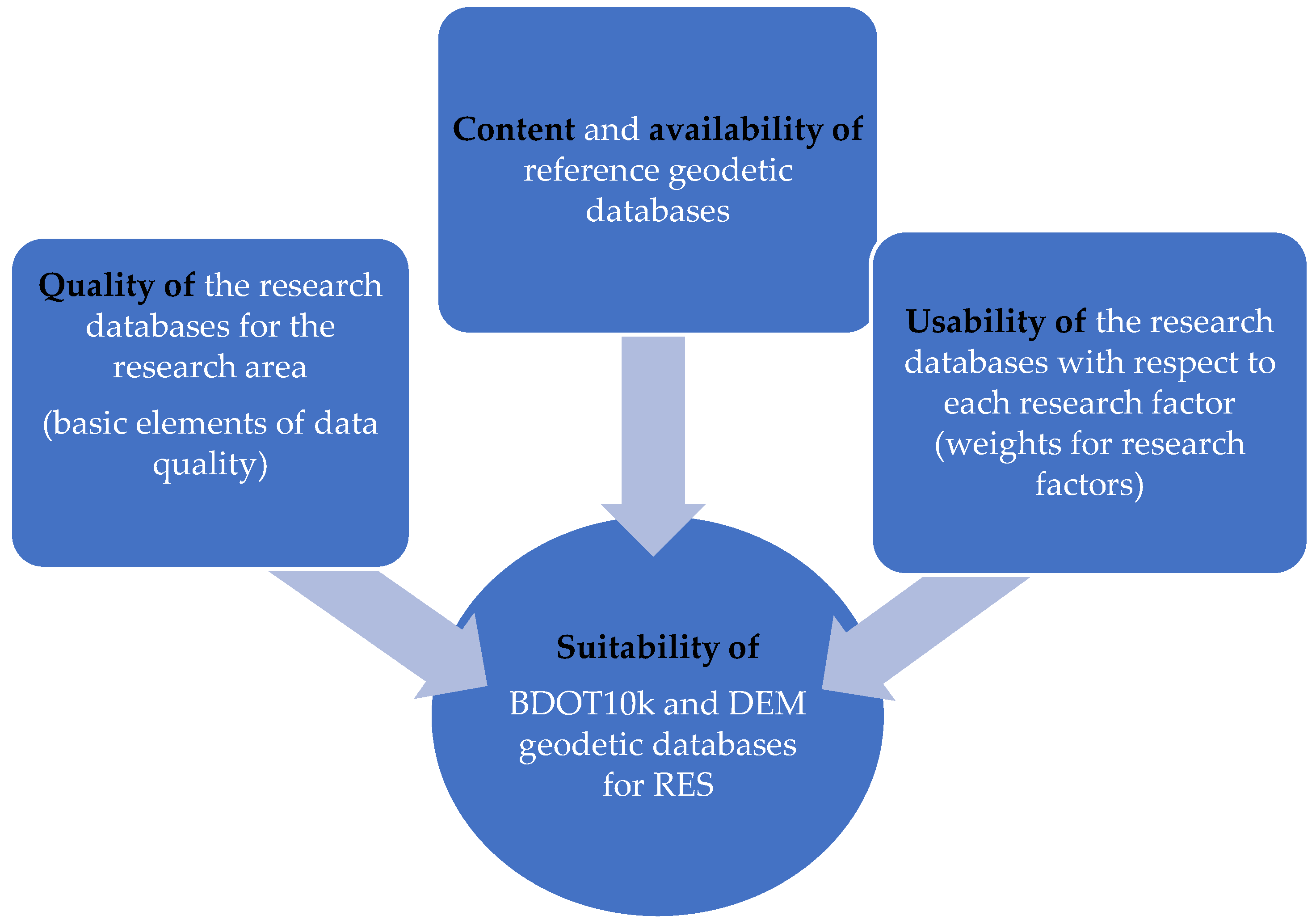
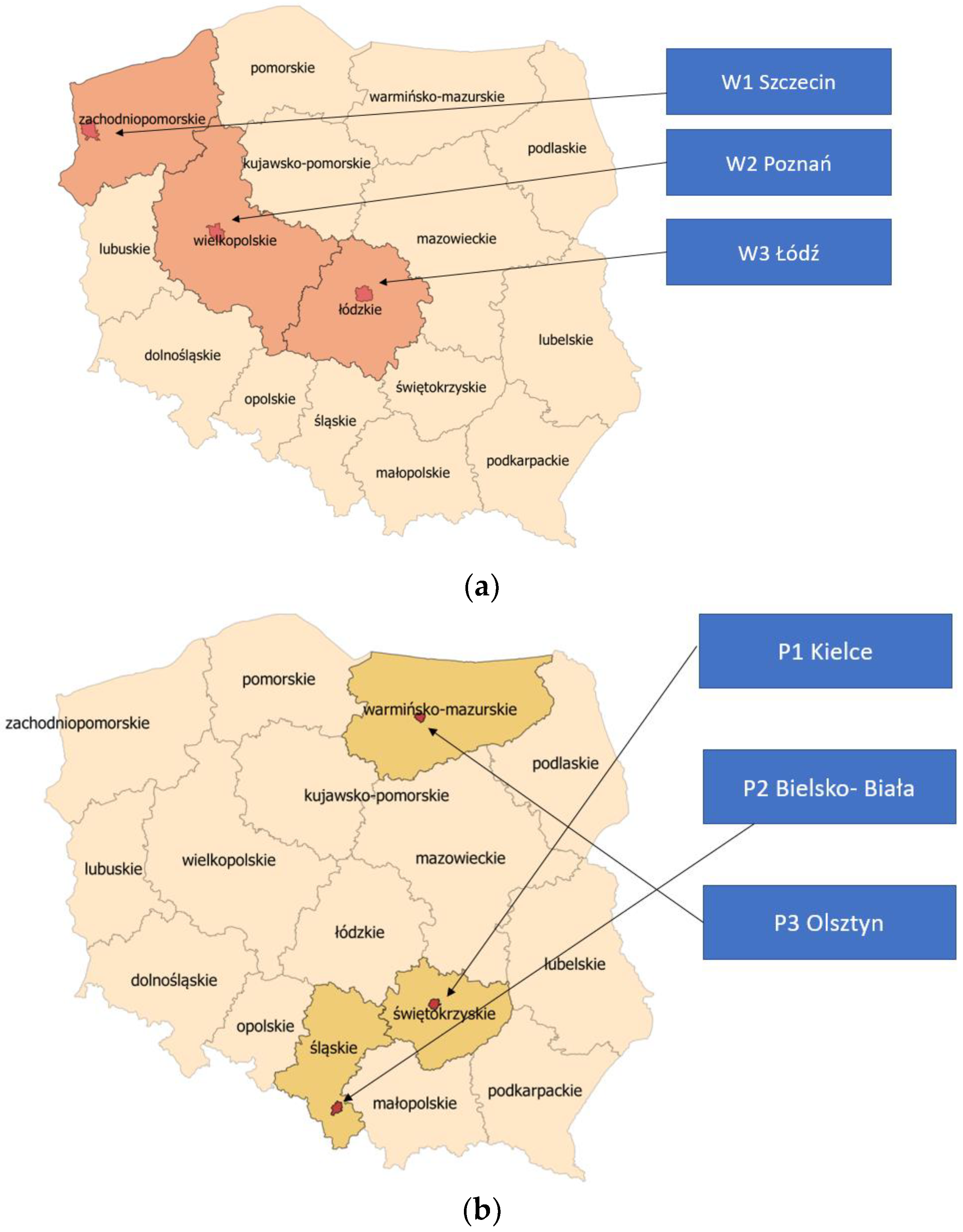
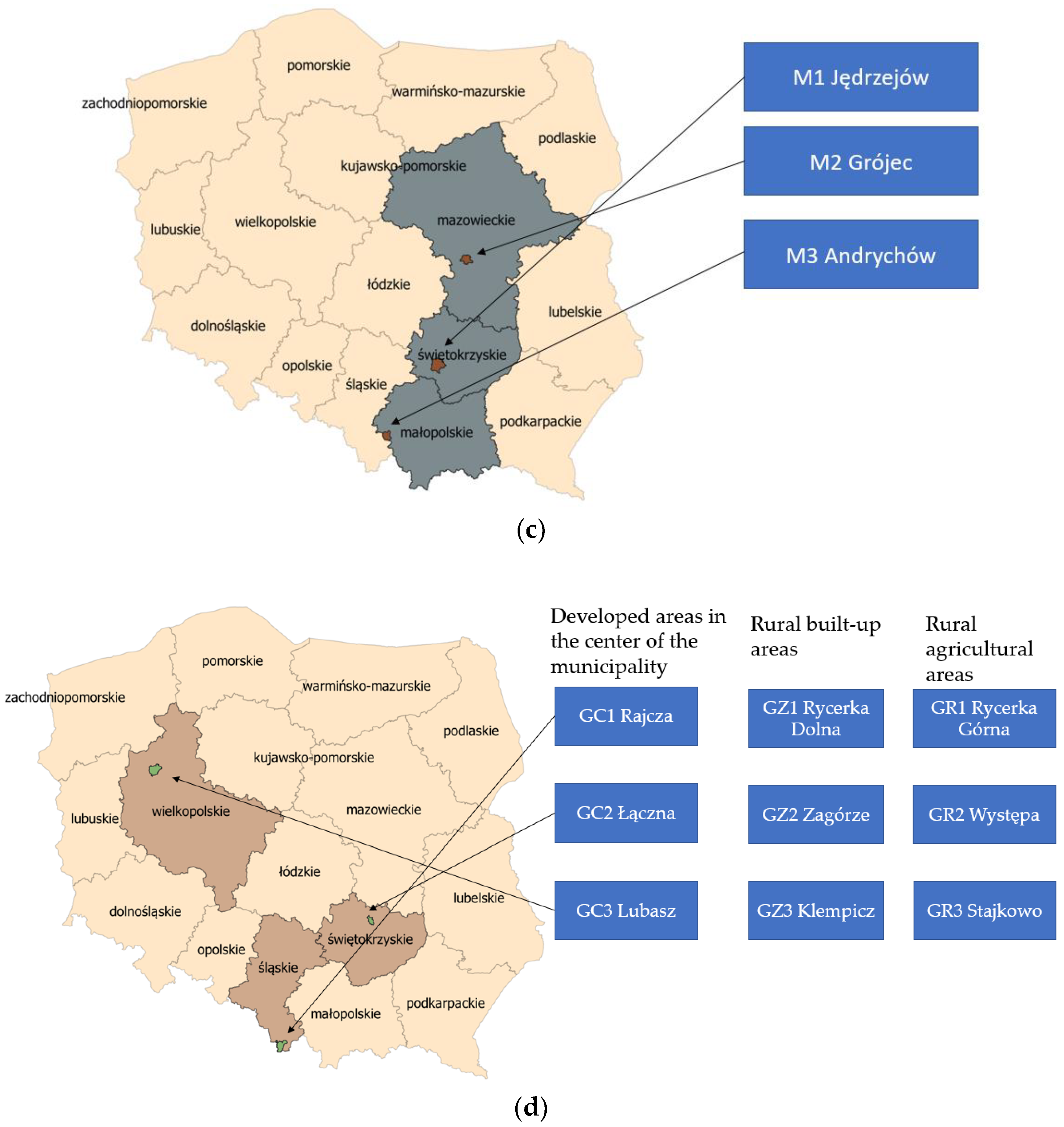
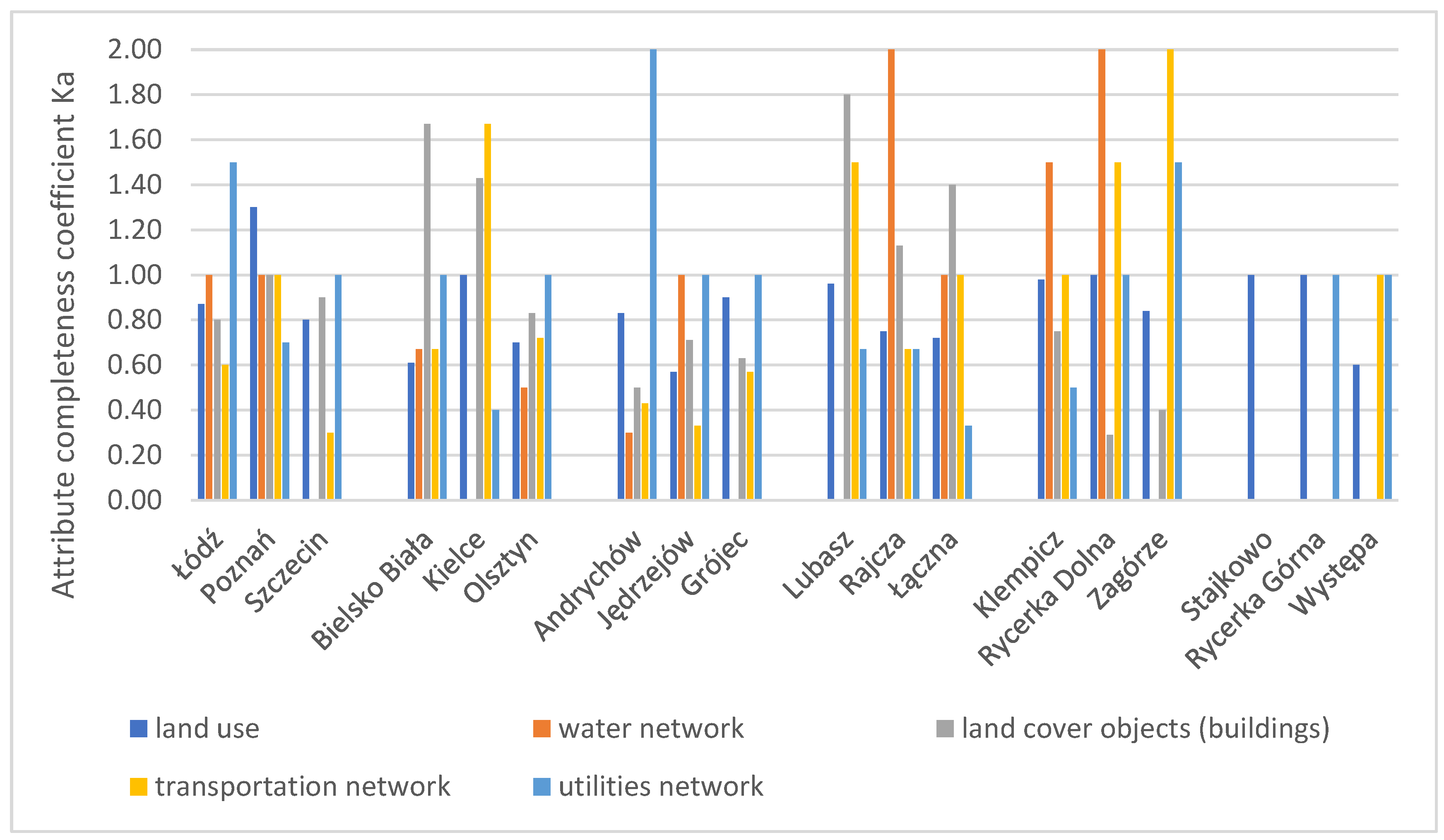


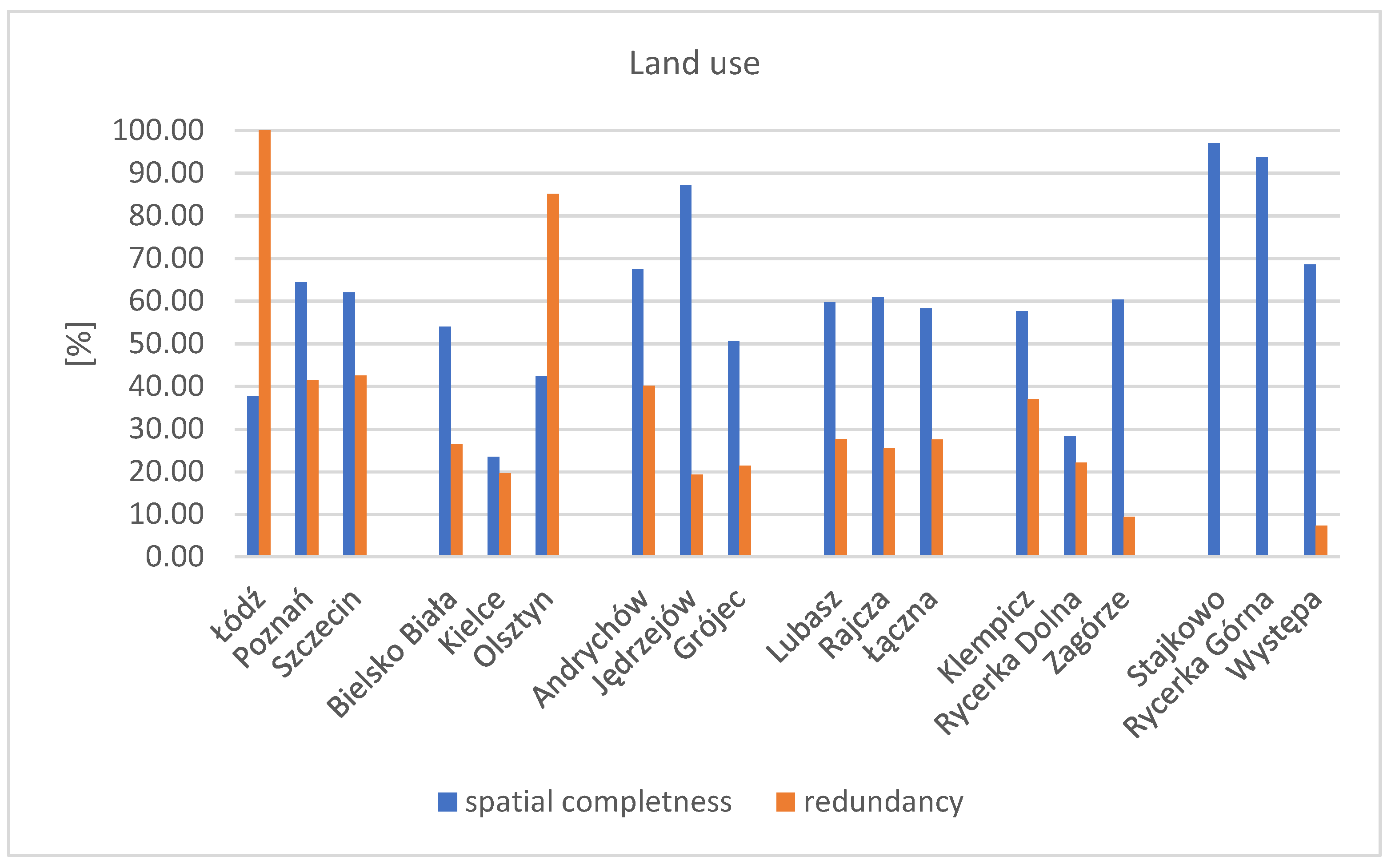
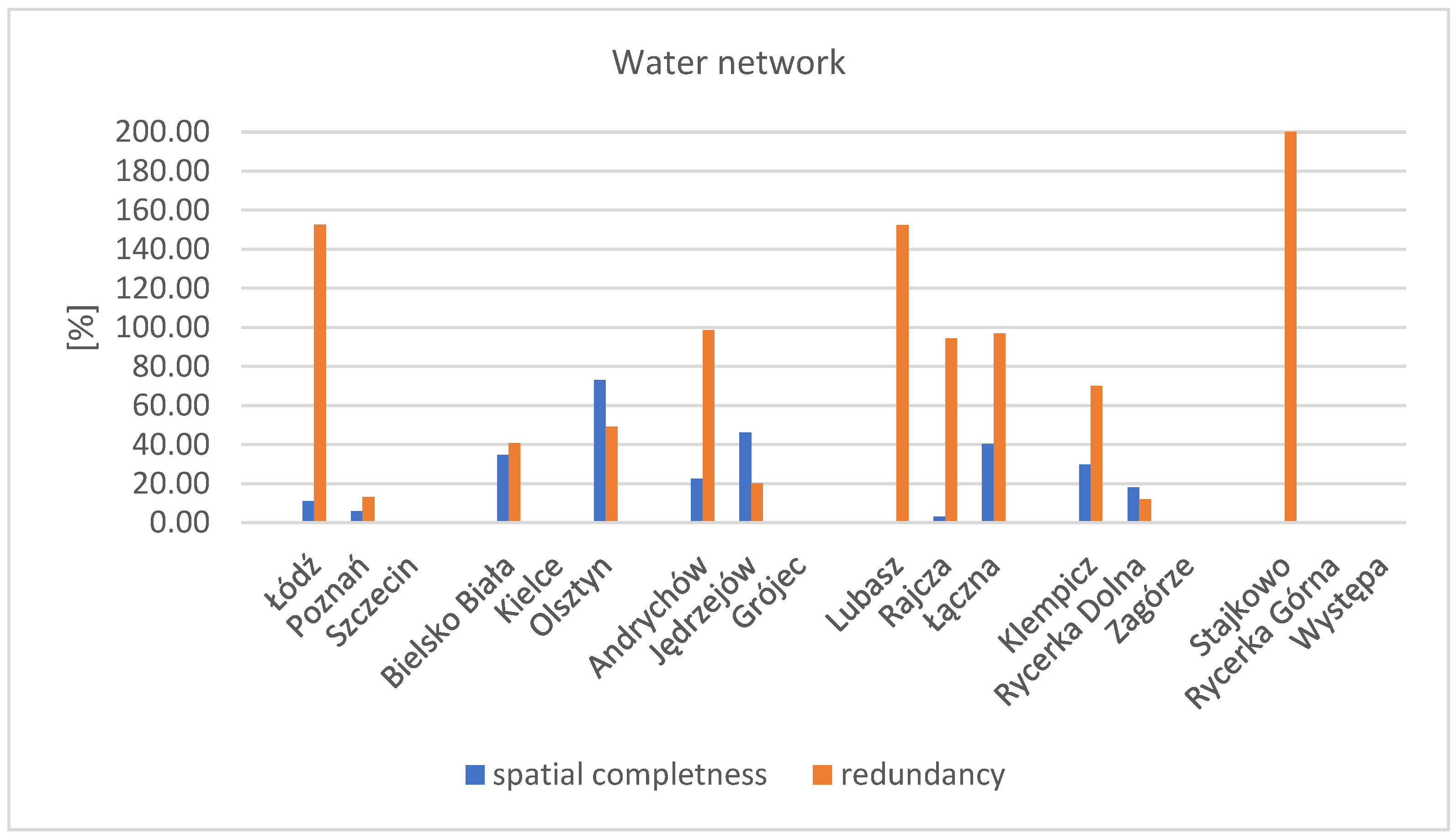

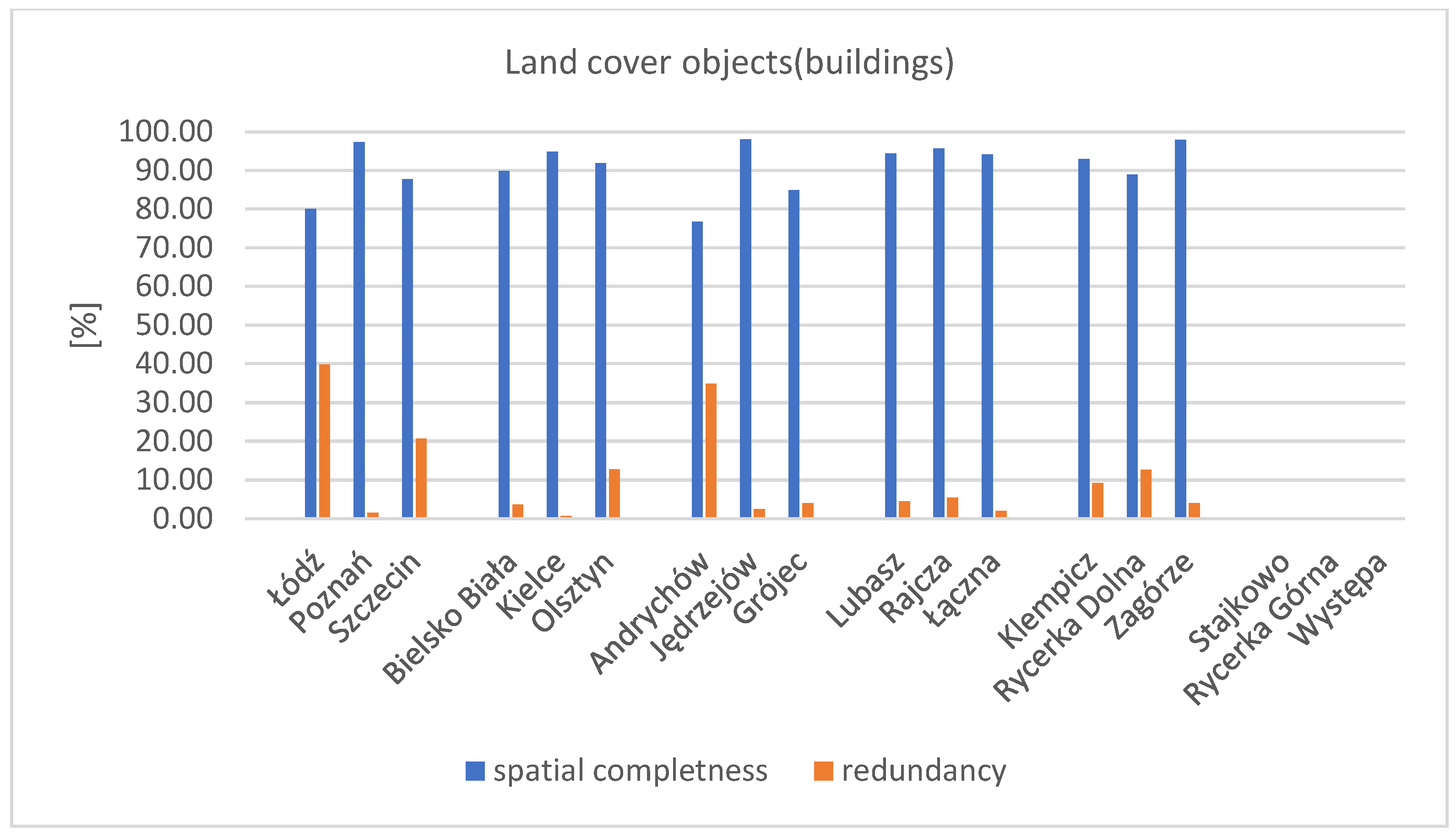
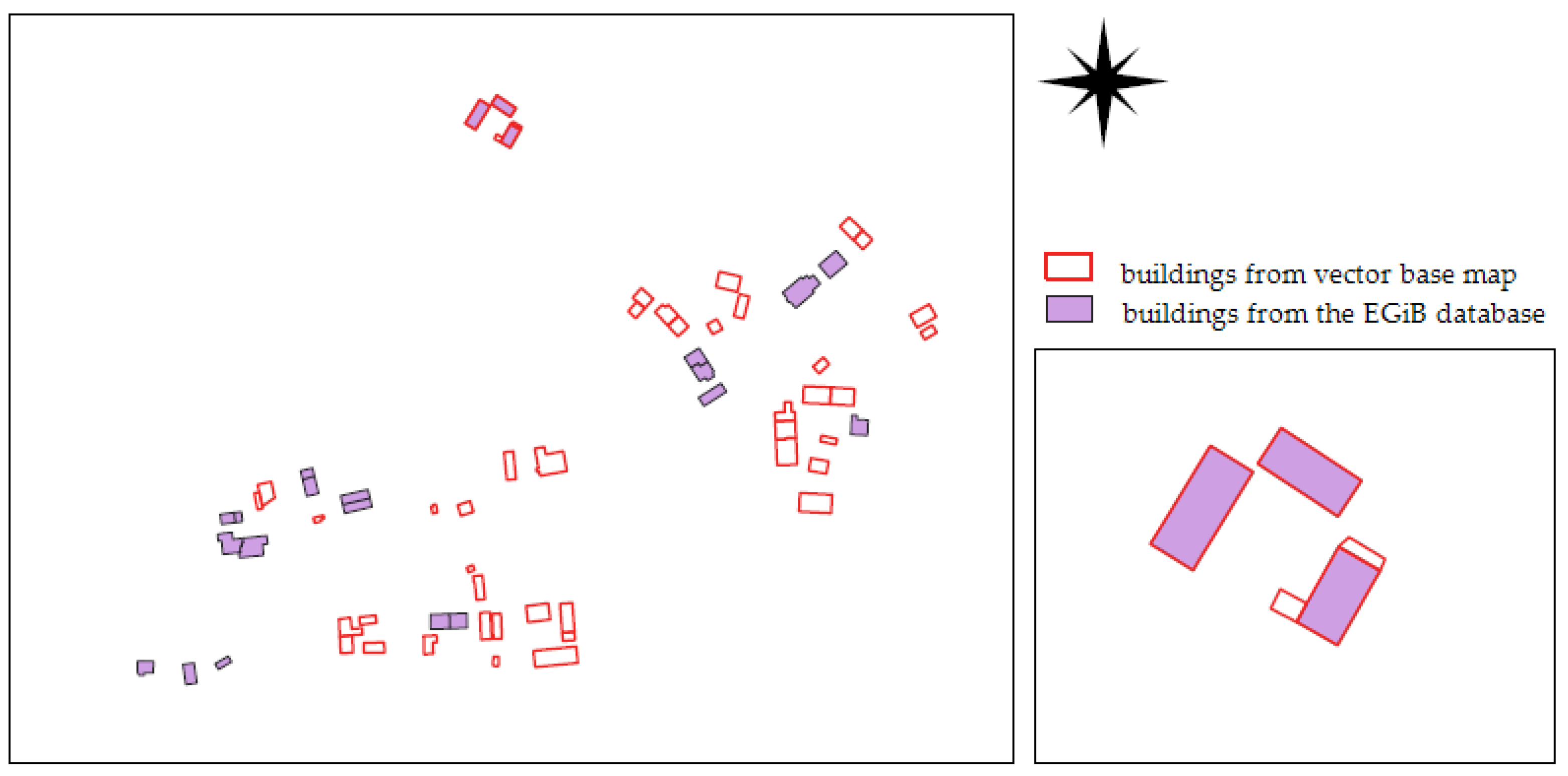
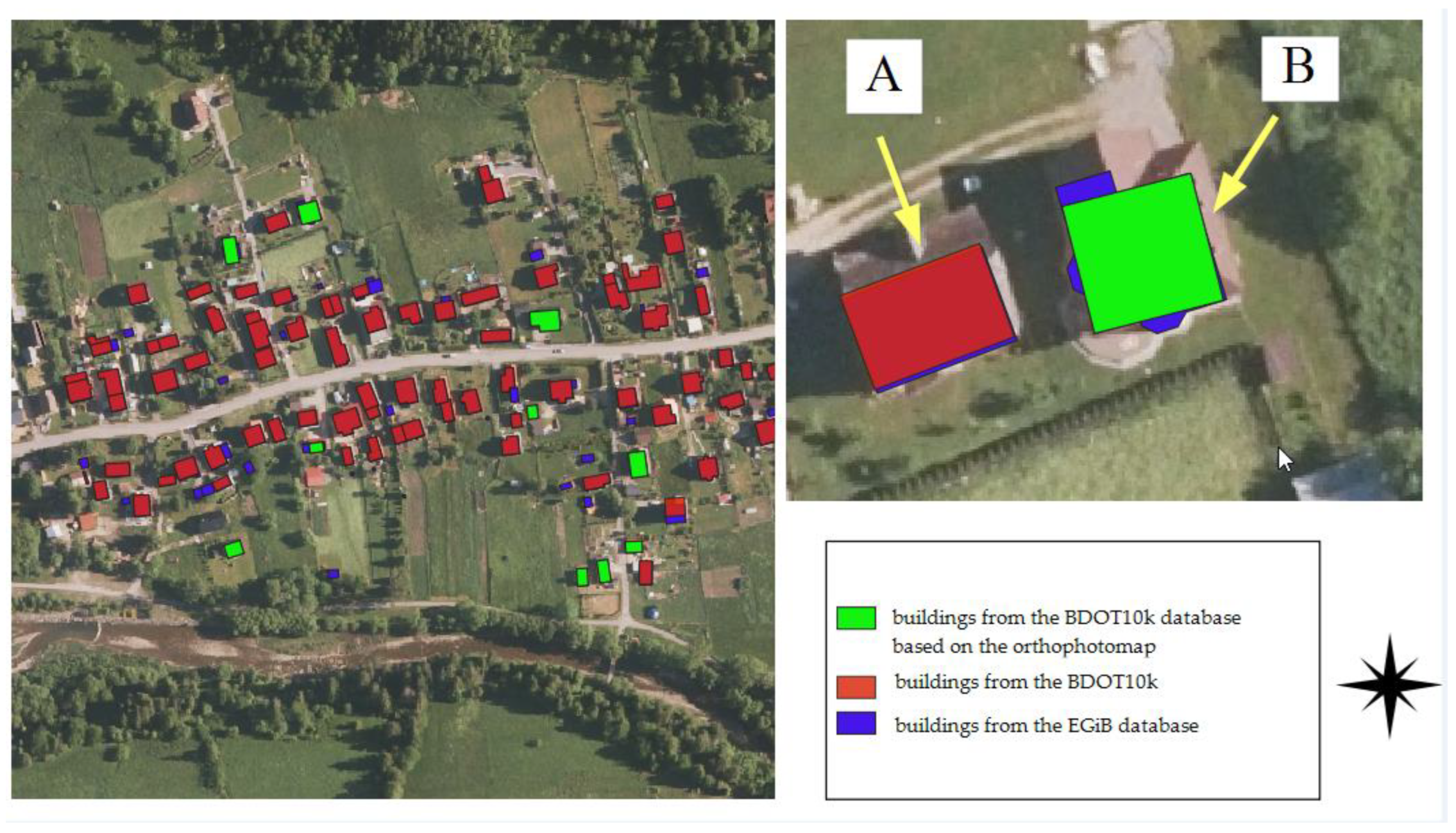
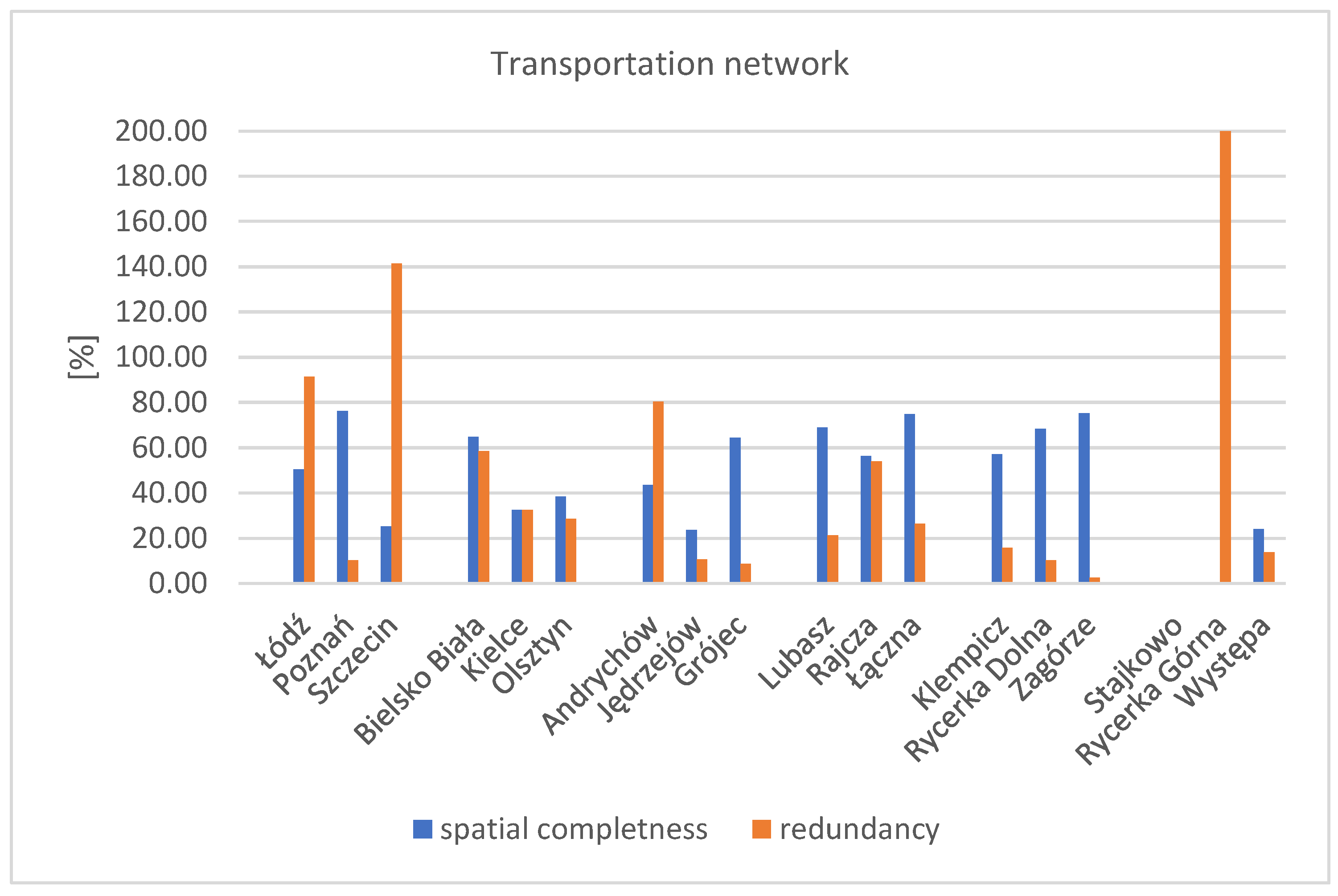
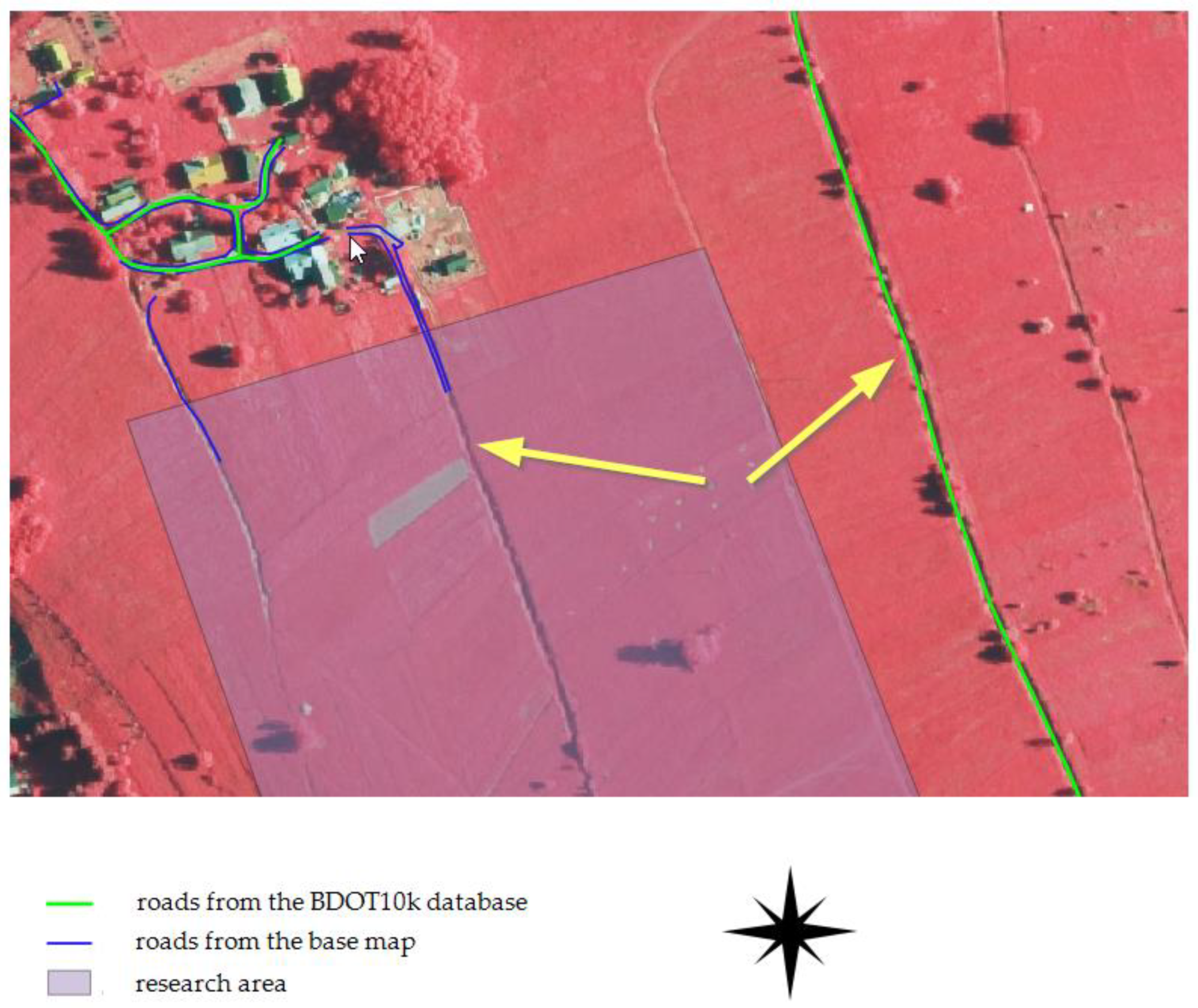
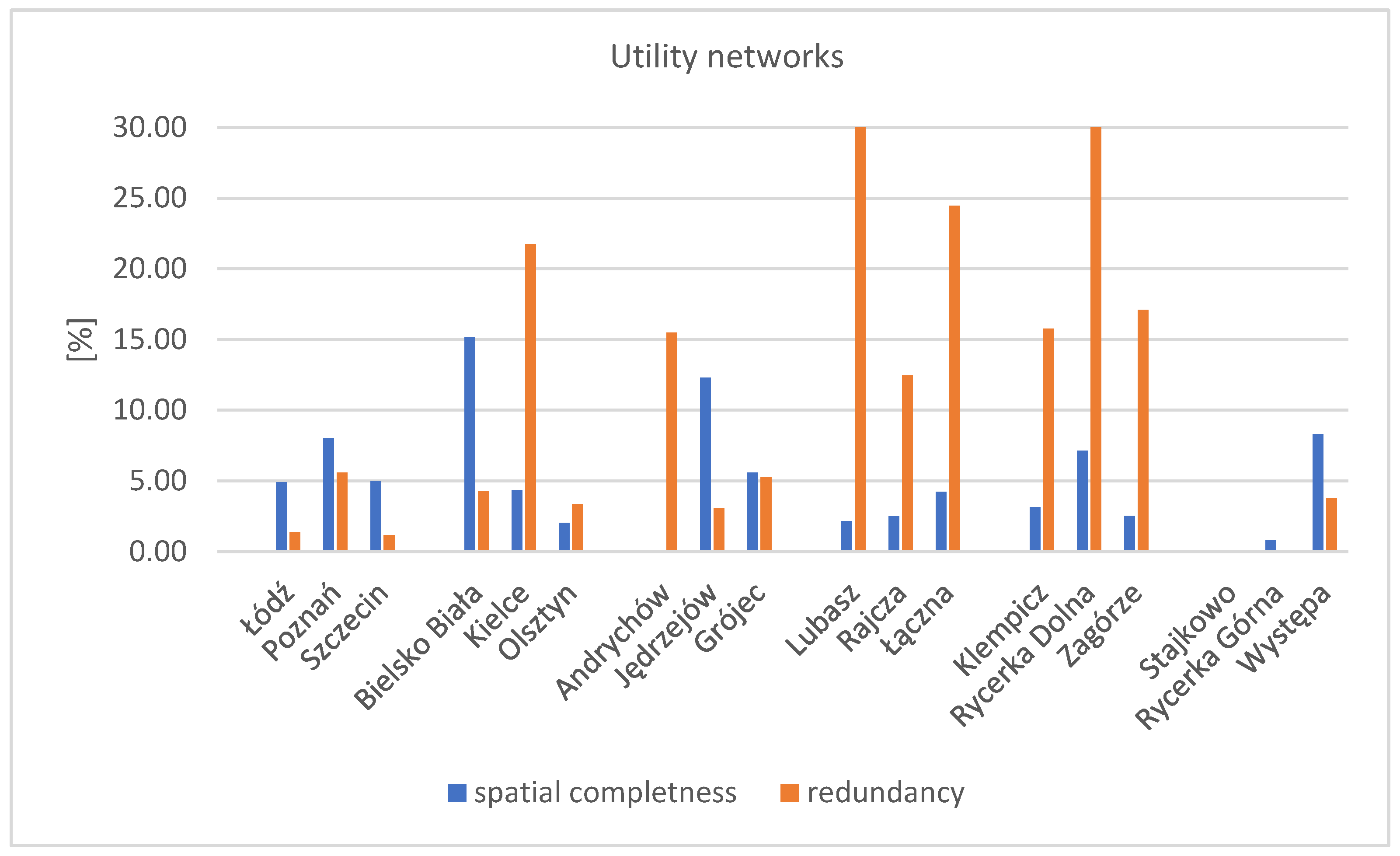
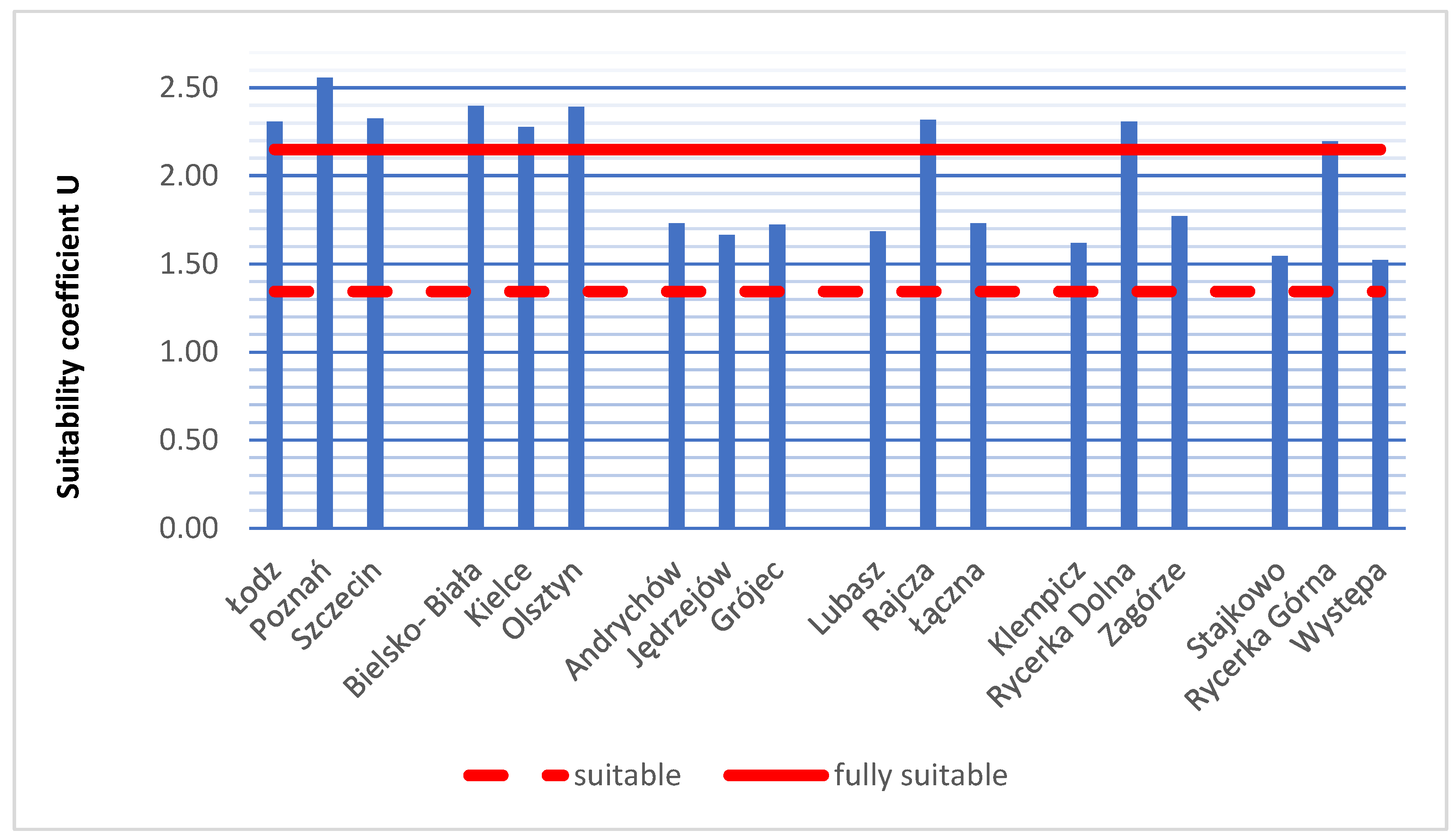
| Environmental (Ecological) Criteria | Location (Distance) Criteria | Social Criteria in the Context of the Profits from the Construction of the Power Plant for the Local Society | Topographic Criteria | Technical (Engineering) Criteria | Economic Criteria in the Context of Increasing the Efficiency of Power Plants | Climate Criteria | Legal and Administrative Criteria |
|---|---|---|---|---|---|---|---|
|
|
|
|
|
|
|
|
| Environmental (Ecological) Criteria | Location (Distance) Criteria Exclusion of Areas and Buffer Zones | Social Criteria in the Context of the Profits from the Construction of the Power Plant for the Local Society | Topographic Criteria | Technical (Engineering) Criteria | Economic Criteria in the Context of Increasing the Efficiency of Power Plants | Climate Criteria | Legal and Administrative Criteria |
|---|---|---|---|---|---|---|---|
|
|
|
|
|
|
|
|
| Environmental/ Ecological Criteria | Economic Criteria | Social Criteria | Topographic and Geological Criteria | Technical (Engineering) Criteria | Hydrological Criteria | Legal and Administrative Criteria |
|---|---|---|---|---|---|---|
|
|
|
|
|
|
|
| Abbreviated Name of the Database in Polish | Full Name of the Database in English | Public Database Free of Charge | Authority in Charge of the Database Determination of Part of the National Geodetic and Cartographic Resource (PZGiK) |
|---|---|---|---|
| BDOO | Database of General Geographical Objects | + | Head Office of Geodesy and Cartography (GUGiK) Central Geodetic and Cartographic Resource |
| PRG | National Register of Boundaries | + | |
| PRNG | National Register of Geographical Names | + | |
| PRPOG | National Register of Basic Geodetic, Gravimetric and Magnetic Networks | + | |
| BDZLiS | Databases for aerial and satellite imagery, orthophotomap and digital elevation models-part containing data of aerial and satellite imagery | − | |
| ORTO | Databases for aerial and satellite imagery, orthophotomap and digital elevation models-part containing orthophotomaps | + | |
| NTM | Databases for aerial and satellite imagery, orthophotomap and digital elevation models-part containing data of the digital elevation model (DEM), digital surface model (DSM) and measurement data from laser scanning | + | |
| BDOT10k | Topographic Objects Database scale 1:10,000 | + | Regional Marshal provincial part of PZGiK |
| EGiB | Land and Building Register | +/− | Staroste district part of PZGiK |
| GESUT | Utilities Network Database | − | |
| BDOT500 | Topographic Objects Database scale 1:500 | − | |
| BDSOG | Detailed Control Network Database | + | |
| RCN | Real Estate Price Register | − |
| Research Factor | The Researched Thematic Scope within the Factor | Geodetic Database | |
|---|---|---|---|
| Research Database | Reference Database | ||
| Land use | Agricultural land | BDOT10k | EGiB |
| Built-up areas | |||
| Forest areas | |||
| Water network | Watercourses | BDOT10k | BDOT500 |
| Canals, drainage ditches | |||
| Water reservoirs | |||
| Land cover objects | Buildings | BDOT10k | EGiB |
| Transportation network (road and rail) | Roadways | BDOT10k | BDOT500 |
| Railway tracks | |||
| Utility networks | Overhead utility networks | BDOT10k | GESUT |
| Terrain elevation | Elevation above sea level | NTM | BDOT500 |
| Geodetic Database | Name of Object Category (Layer) | Code (Layer Designation) | Representation | Attribute |
|---|---|---|---|---|
| BDOT10k Research database | Forest or wooded area | OT_PTLZ | surface | forest |
| coppice | ||||
| tree cover | ||||
| Development | OT_PTZB | surface | multi-family | |
| single-family | ||||
| industrial and warehouse | ||||
| commercial and service | ||||
| other buildings | ||||
| Grassland and agricultural crops | OT_PTTR | surface | Grass arable land cultivation | |
| EGiB Reference database | Contour of land use | EGB_OFU | surface | Forest, wooded, and bush land: Ls, Lz, Lzr |
| Developed land: B, Br, Bi, Ba, Bz | ||||
| Agricultural land: R, Ps, Ł |
| Geodetic Database | Name of Object Category (Layer) | Code (Layer Designation) | Representation | Attribute |
|---|---|---|---|---|
| BDOT10k Research database | Surface water | OT_PTWP | surface | seawater |
| flowing water | ||||
| stagnant water | ||||
| Surface water | OT_SWRS river and stream | line | river, | |
| stream, creek, or brook | ||||
| OT_SWKN canal | line | canal | ||
| OT_SWRM drainage ditch | line | drainage ditch | ||
| BDOT500 Reference database | Water | OTWP | surface | flowing water |
| OTWS | surface | stagnant water | ||
| OTWM | line | drainage ditch |
| Geodetic Database | Name of Object Category (Layer) | Code (Layer Designation) | Representation | Attribute |
|---|---|---|---|---|
| BDOT10k Research database | Building | OT_BUBD | surface | General function of the building: |
| Industrial buildings | ||||
| Transport and communication buildings | ||||
| Commercial and service buildings | ||||
| Tanks, silos, and storage buildings | ||||
| Office buildings | ||||
| Hospital and other healthcare buildings | ||||
| Education, science and culture buildings and sports buildings | ||||
| Production, service, and farm buildings for agriculture | ||||
| Other non-residential buildings | ||||
| Residential buildings | ||||
| EGiB Reference database | Building | EGB_ building | surface | Type of building according to the Polish Classification of Fixed Assets: |
| Residential (m) | ||||
| Production, service, and farm (g) | ||||
| Transportation and communication (t) | ||||
| Education, science, culture, and sports (k) | ||||
| Hospital and other healthcare buildings (z) | ||||
| Office (b) | ||||
| Commercial and service (h) | ||||
| Industrial (p) | ||||
| Tanks, silos, and storage buildings (s) | ||||
| Non-residential buildings (i) |
| Geodetic Database | Name of Object Category (Layer) | Code (Layer Designation) | Representation of the Objects | Attribute | |
|---|---|---|---|---|---|
| BDOT10k Research database | Transportation network | OT_SKJZ road | line | road class | motorway |
| expressway | |||||
| main traffic artery | |||||
| major road | |||||
| collector road | |||||
| local road | |||||
| access road | |||||
| other roads | |||||
| surface material | concrete | ||||
| cobblestone | |||||
| natural soil | |||||
| paving stone | |||||
| prefabricated paving blocks | |||||
| bitumen | |||||
| concrete slabs | |||||
| gravel | |||||
| crushed stone | |||||
| other | |||||
| OT_SKTR track or set of tracks | line | type of rail vehicle | railroad | ||
| underground | |||||
| tram | |||||
| BDOT500 Reference database | Transport | OTKJ roadway | Line or surface | surface type | bitumen (j.mb.) |
| cobblestone (j.kb.) | |||||
| concrete slabs (j.pb.) | |||||
| concrete (j.bt.) | |||||
| gravel or crushed stone (j.zw) | |||||
| natural soil (j.gr.) | |||||
| OTKT track | line | Railroad track | |||
| Tram track | |||||
| Underground track | |||||
| Other tracks | |||||
| Geodetic Database | Name of Object Category (Layer) | Code (Layer Designation) | Representation | Attribute |
|---|---|---|---|---|
| BDOT10k Research database | Utility networks | OT_SULN power line | line | Ultra-high voltage power line |
| High voltage power line | ||||
| Medium voltage power line | ||||
| Low voltage power line | ||||
| Telecommunications line | ||||
| GESUT Reference database | Ground and aboveground utility networks | SUEP | line | Ultra-high voltage power cable (ww) |
| High voltage power cable (w) | ||||
| Medium voltage power cable (s) | ||||
| Low voltage power cable (n) | ||||
| SUTP telecommunication cable | line | Optical fibre telecommunication cable (s) | ||
| Other telecommunication cable (i) |
| Geodetic Database | Name of Object Category (Layer) | Code (Layer Designation) | Representation of the Objects | Attribute | |
|---|---|---|---|---|---|
| DEM Research database | - | - | raster | point height H | |
| BDOT500 Reference database | Terrain features | OTR | point | Type of elevation | OTRS Artificial survey point |
| OTRN Natural survey point | |||||
| Factor | Utility Scales for RES [W] | Sun | Wind | Water |
|---|---|---|---|---|
| Land use | 3 | + | + | + |
| Utility networks | 2 | + | + | - |
| Transportation network (road and rail) | 2 | + | + | - |
| Land cover objects (buildings) | 2 | + | + | - |
| Water network | 1 | - | - | + |
| Terrain elevation | 3 | + | + | + |
| Data Development Level | Score |
|---|---|
| Complete object-oriented database | 1.0 |
| Part of the data in the form of object-oriented databases + vector base map | 0.8 |
| No database + vector base map | 0.7 |
| Part of the data in the form of object-oriented databases + hybrid base map (vector + raster) | 0.4 |
| No database hybrid base map (vector + raster) | 0.3 |
| Raster with georeferencing | 0.2 |
| Copy of analogue map | 0 |
| Name of Locality | Test Area Designation | Thematic Scope of Data | Coefficient Rd | ||
|---|---|---|---|---|---|
| EGiB | BDOT500 | GESUT | |||
| Score | |||||
| Szczecin | W1 | 1 | 1 | 1 | 1.00 |
| Poznań | W2 | 1 | 1 | 1 | 1.00 |
| Łódź | W3 | 1 | 1 | 1 | 1.00 |
| Kielce | P1 | 0.8 | 0.8 | 1 | 0.86 |
| Bielsko-Biała | P2 | 1 | 1 | 1 | 1.00 |
| Olsztyn | P3 | 1 | 1 | 1 | 1.00 |
| Jędrzejów | M1 | 0.3 | 0.3 | 0.3 | 0.30 |
| Grójec | M2 | 0.8 | 0.7 | 0.7 | 0.73 |
| Andrychów | M3 | 1 | 1 | 0.7 | 0.90 |
| Rajcza | GC1 | 0.8 | 0.7 | 0.7 | 0.73 |
| Rycerka Dolna | GZ1 | 0.8 | 0.7 | 0.7 | 0.73 |
| Rycerka Górna | GR1 | 0.8 | 0.7 | 0.7 | 0.73 |
| Łączna | GC2 | 0.7 | 0.7 | 0.7 | 0.70 |
| Zagórze | GZ2 | 0.7 | 0.7 | 0.7 | 0.70 |
| Występa | GR2 | 0.3 | 0.7 | 0.7 | 0.56 |
| Lubasz | GC3 | 0.8 | 0.4 | 0.4 | 0.53 |
| Klempicz | GZ3 | 0.8 | 0.4 | 0.4 | 0.53 |
| Stajkowo | GR3 | 0.8 | 0.4 | 0.4 | 0.53 |
| Coefficient Designation | Full Name | Additional Explanations |
|---|---|---|
| attribute completeness coefficient | Coefficients related to the examined elements of BDOT10k database data quality | |
| spatial completeness coefficient | ||
| spatial redundancy coefficient | ||
| coefficient Kp for the land use factor | Spatial completeness coefficient Kp of the BDOT10k | |
| coefficient Kp for the water network factor | ||
| coefficient Kp for the land cover objects (buildings) factor | ||
| coefficient Kp for the transportation network factor | ||
| coefficient Kp of the BDOT10k database for utilities network factor | ||
| the mean elevation error | For the DEM dataset, as specified in the metadata | |
| coefficient | The average value from the preliminary assessment of the three reference databases (EGiB, BDOT500, GESUT) | |
| suitability coefficient | Of the BDOT10k and DEM databases |
Disclaimer/Publisher’s Note: The statements, opinions and data contained in all publications are solely those of the individual author(s) and contributor(s) and not of MDPI and/or the editor(s). MDPI and/or the editor(s) disclaim responsibility for any injury to people or property resulting from any ideas, methods, instructions or products referred to in the content. |
© 2024 by the authors. Licensee MDPI, Basel, Switzerland. This article is an open access article distributed under the terms and conditions of the Creative Commons Attribution (CC BY) license (https://creativecommons.org/licenses/by/4.0/).
Share and Cite
Front-Dąbrowska, T.; Kwartnik-Pruc, A. Evaluation of the Suitability of Geodetic Databases to Support the Process of Locating Renewable Energy Investments. Energies 2024, 17, 4919. https://doi.org/10.3390/en17194919
Front-Dąbrowska T, Kwartnik-Pruc A. Evaluation of the Suitability of Geodetic Databases to Support the Process of Locating Renewable Energy Investments. Energies. 2024; 17(19):4919. https://doi.org/10.3390/en17194919
Chicago/Turabian StyleFront-Dąbrowska, Teresa, and Anita Kwartnik-Pruc. 2024. "Evaluation of the Suitability of Geodetic Databases to Support the Process of Locating Renewable Energy Investments" Energies 17, no. 19: 4919. https://doi.org/10.3390/en17194919
APA StyleFront-Dąbrowska, T., & Kwartnik-Pruc, A. (2024). Evaluation of the Suitability of Geodetic Databases to Support the Process of Locating Renewable Energy Investments. Energies, 17(19), 4919. https://doi.org/10.3390/en17194919









